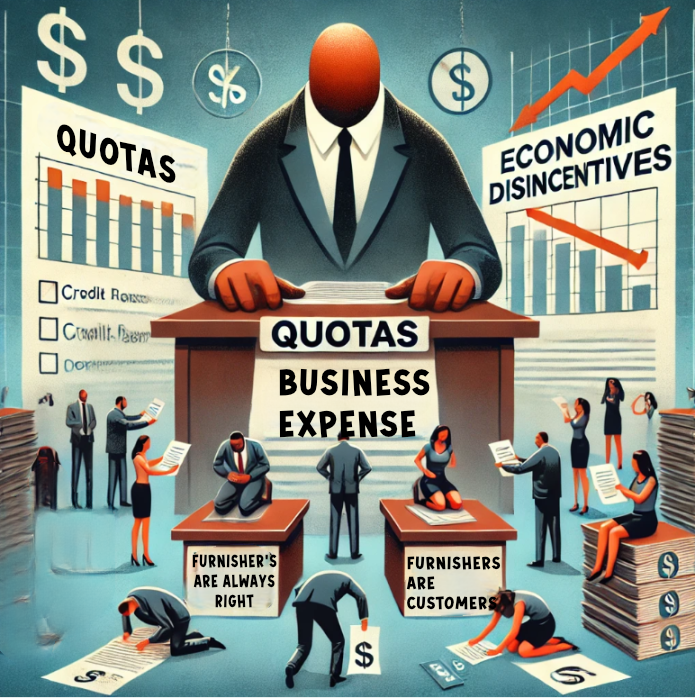E OSCAR System How Does It Function
E OSCAR (Online Solution for Complete and Accurate Reporting)
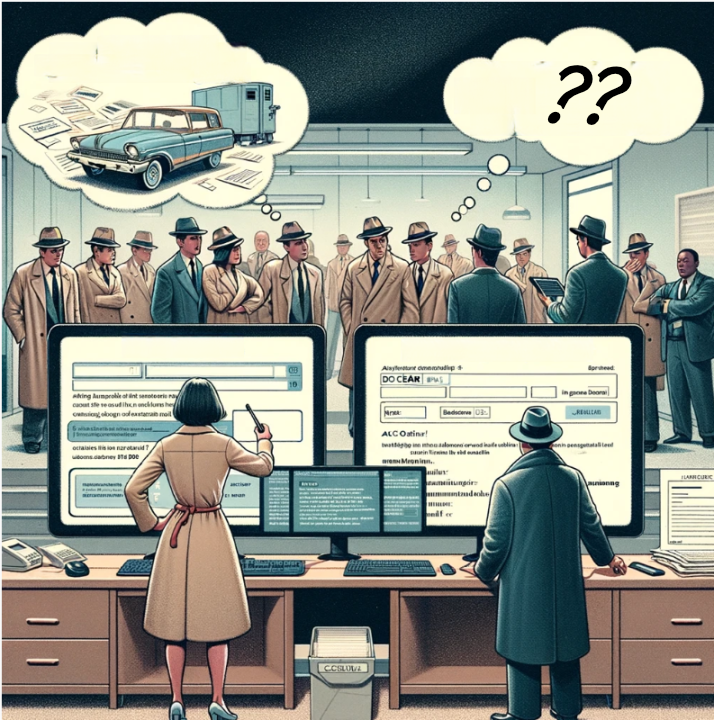
How An Investigation is conducted
What do you think of when you hear or see the word “investigation”? Probably somewhere along the lines of document review, fact research, interviews with both parties, and handwriting comparison. Here is an example, these are some of the duties a fraud investigator would perform for Zales Jewelers:
- Securing original documents, such as the credit application, sales slips, and any written accounts from store staff.
- Obtaining copies of identification documents and police reports.
- Analyzing the signatures on the sales slip and the credit application.
- Conducting interviews with store employees, including the manager and the sales associate involved in the transaction.
- Drafting statements for store employees to endorse or recording notes during interviews.
- Questioning the fraud victim to collect more details that may aid in identifying a suspect or understanding the nature of the fraud or forgery.
That sounds about right. How much do you think this investigation would cost Zales Jewelers? How long do you think it would take to complete the investigation? Keep those two questions in mind. Now you probably do not want to know what you’re going to read. But even though it sounds like bad news, you can use this information to your advantage.
The E-OSCAR system, was created, designed and deployed by the credit bureaus. It summarizes detailed dispute letters into dispute codes. This highly automated and computer-driven process uses an electronic form called an Automated Consumer Dispute Verification (ACDV) form. This is the only form of communication between the credit bureaus and the furnishers.
Key Points of the e-OSCAR Process:
- Automated Dispute Forms: The ACDV form, streamlines the dispute into one- or two-digit codes that represents the consumer’s detailed concerns.
- Limited Interaction: Initiated through an online system, e-OSCAR diminishes the human element in processing disputes. At first there were 100 codes that were available to choose from. Today the number of available options is 26 and E-OSCAR is heavily dependent on the dispute codes to categorize and communicate issues.
- Loss of Supporting Documents: Supporting documentation, like billing statements and letters from consumers, which provide substantial proof of disputes, are not passed along when the codes are sent to furnishers.
- Codes Usage: Three of the twenty-six dispute codes are used for majority of disputes. The details of each individual dispute are not addressed. With such a complex system, three dispute codes cannot cover the spectrum of issues that consumers have.
Disadvantages Highlighted:
- Inadequate Responses: Following a quick investigation with a minimum effort, consumers receive generic responses from the credit bureaus that are meaningless. They lack details, justification, and explanation of the findings. They are not required to provide written explanation of their investigations. It is only when the consumer requests written details of their findings is when they are required to provide written explanation.
- Limited Categorization and Generic Notices: Examples from court cases reveal how responses from the bureaus fail to address specific consumer disputes. The results are generic notifications that do not resolve or appropriately acknowledge the issues raised by the consumers.
You need to understand the rights that consumers have. Under the Fair Credit Reporting Act (FCRA), you have certain automatic rights, but many key protections only kick in if you actively pursue them. Here’s a breakdown:
Automatic Rights:
- Dispute Process: If you challenge an error on your credit report, the credit agency must investigate it within 30 days.
- Notification of Adverse Actions: If a decision negatively affects you (like being denied a loan or job) based on your credit report, you’ll automatically be notified, including who provided the report.
- Reinsertion Notice: If something that was removed from your report gets put back, the agency must inform you within five days.
Rights that Require Your Action:
- Seeing Your Credit Report: You must request a copy to see the outcome of a dispute or the current state of your report.
- Verification Requests: If you need more details about specific items on your report, you must ask for this in “writing”.
- Free Credit Reports: After a fraud alert, you must ask for your free reports; they aren’t sent automatically. You’re entitled to one free report per year from each major agency, but you need to request additional ones.
- Adding a Statement of Dispute: If you’re not happy with how a dispute was resolved, you must ask to add a statement to your file.
What You Could Lose by Not Acting:
- Not Disputing Errors: If you don’t challenge errors, they won’t be corrected, which could keep harming your credit.
- Ignoring Notifications: Not following up on adverse actions or reinserted items could mean missing chances to correct them.
- Not Requesting Detailed Information: Failing to ask for verification or details about disputes could leave you without essential info needed to challenge inaccuracies.
In short, while the law gives you some automatic protections, you need to be proactive to make the most of your rights under the FCRA. Not taking action can lead to missed opportunities to fix issues on your credit report.
Online Credit Disputing: A Cautionary Guide
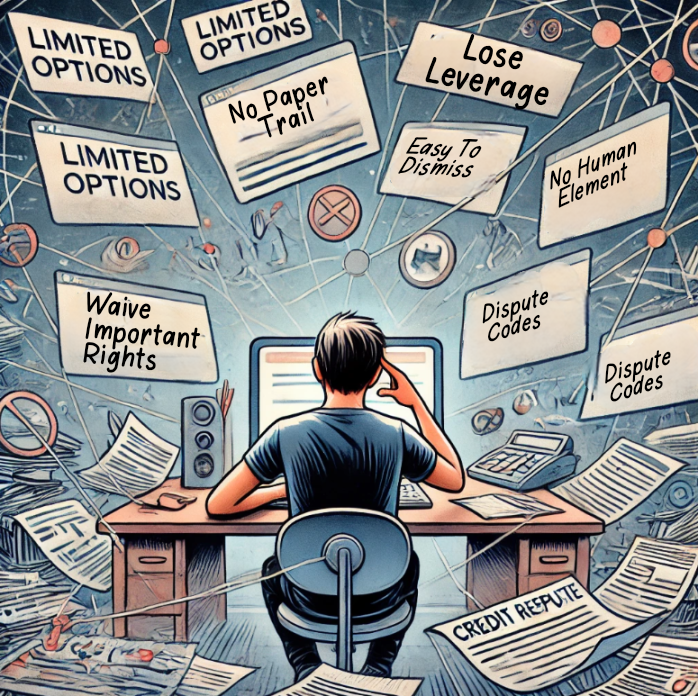
E OSCAR system revolves around the standardized dispute codes. The only reason E OSCAR was created, was to eliminate disputes as fast as possible. Because the credit bureaus receive thousands of dispute letters daily. They cannot possibly address them all. However, the FCRA legally requires the credit bureaus to investigate all disputes. Some letters are lost, ignored, and mishandled. The high volume of disputes overwhelms the system and staff. Here is the catch, the credit bureaus claim that their careless investigations under the FCRA is because of frivolous disputes from credit repair organizations. Who make guarantees to consumers to be able to delete accurate negative information from credit files. Only 30% of disputes at credit bureaus are linked to such cases so that claim doesn’t hold any weight.
The Economics of Credit Reporting
A. Identifying the Customer
Do not think that the credit bureaus are looking out for consumers’ best interest. They are a business, and their main clients are the creditors. Creditors have access to their databases and use the data to market financial products to very targeted consumers. That is why a creditor decides to report their information to the credit bureau. The credit bureaus have reporting fees. They generate revenue in other ways, for instance, credit monitoring services. But the furnishers is where they generate more revenue.
Consumers unfortunately, are caught up in the mix of the relationship between the creditor and the credit bureaus. Consumers have no say so about the data about them, being in their databases. We cannot have them remove the data from their databases and for the majority of Americans, establishing a credit history is essential for significant life events. The purchasing of a house, funding an education, or purchasing an automobile. The data in their databases about consumers will impact many other areas of life. We, consumers cannot walk away with the information if we do not like how the information on us is being handled. The creditor owns the information.
The creditor, on the other hand, can take their business elsewhere. So, if a creditor only reports to Experian and their credit dispute investigations are thorough like Zales fraud investigations and the outcome results in favor of the consumer. Experian will ruin their customers’ ability to collect. Ultimately losing profits for their customer and driving them away. If it comes down to siding with the furnisher or siding with the consumer, who do you think the credit bureau is going to side with?
Credit disputes are also costly. Whatever the cost of a Zales fraud investigation is, multiply that by 1000. The expense is going to offset any profit made. E-OSCAR system is the credit bureaus way of reducing business expenses. Do you ever wonder what the terms and conditions are, when you use online disputing? Before you open a dispute, you must agree to their terms and conditions. It’s never straightforward, but at the end of the day, the consumer agrees to waive their right to request written details of the investigation. And cannot challenge the outcome if it is not in their favor. Those are the most important rights that a consumer can exercise. There is a good chance that your online dispute will be misclassified because there isn’t any human judgement, interaction or common sense. And the credit bureaus don’t have IT techs that will dive into the systems files and correctly classify a dispute. In fact, trying to correct a misclassified dispute is perceived as gaming the system, which leads to the dispute getting flagged as frivolous. There is no paper trail and no evidence of negligence when disputing online. You want your letters to have human interaction. The credit experts only dispute through U.S. Postal Service, so we will follow their lead.
Key Concerns with Online Disputing:
- Limited Consumer Rights: Engaging in online disputes often involves accepting terms and conditions that waive crucial consumer protections. Online systems, including terms of service that users rarely read, can strip you of the right to a detailed explanation of the investigation process and allow the reinsertion of negative items with little to no recourse.
- Inefficiency and Rights Waiver: Online disputing formats like E-OSCAR, designed to streamline bureau processes, tend to oversimplify disputes into numerical codes that can misrepresent the specifics of a dispute case. This digitization lacks human judgment, potentially leading to unresolved or misclassified disputes.
- Lack of Supporting Evidence: The online format does not allow for the attachment of supporting documents, which can lead genuine disputes to be dismissed as “frivolous or irrelevant.”
Credit Scores vs. Credit Reports: The FCRA guarantees free access to your credit report once per year from each of the three major credit bureaus, but it does not cover free access to your credit scores. These are often available at a cost or through credit monitoring services.
Avoid Free Credit Score Websites: Obtaining your credit report from websites offering free credit scores will not be accurate. Numerous third-party sites are known to inflate scores, potentially leading to disappointment. They sign you up for costly credit monitoring services that will not justify the expense. They are only good for monitoring the progress of improving your credit score. Because they are not FICO scores and are always off by decent number of points.
In addition, the only credit scores that are available to the public for purchasing are consumer credit scores. Creditors use FICO’s consumer credit scoring model and credit monitoring service websites use their own scoring models that aim to produce the same results as FICO but do not. The standard for credit scoring is FICO. And their scoring models are proprietary. FICO also has industry specific scoring models that lenders use.
You do not want to rely on consumer credit scores when applying for a mortgage. There are unique aspects of mortgage lending that are taken into account when credit scores are calculated that other types of credit do not. The same goes for the automobile industry. The scoring models aren’t as lenient as the consumer credit scoring model.
This is why you want to focus on the quality of your credit report and do not focus on credit scores.
So, if you wrote a letter that stated any of the above codes. Sent it in with your forms of identification, the dispute is going to be determined as frivolous. And that is basically what is being sent to the furnisher by the investigator except the codes are in numerical form.
Among the major credit bureaus, only Experian handles consumer disputes within the United States. However, Experian doesn’t train their employees to do investigative -type duties.
TransUnion manages its disputes in its consumer relations facility near Philadelphia. The disputes are digitized and then sent to Intelenet in Mumbai, India. This subcontractor gets direct access to TransUnion’s database. The vendors can retrieve consumer credit files and work the Automated Consumer Dispute Verification (ACDV) form. The form includes the consumers personal identifiers to make sure it is the correct consumer. The vendors are required to pick the dispute code listed on the electronic form that best describes the issue and sends it to the furnisher to start an investigation.
Furnishers’ Inadequate Investigations Exacerbate System Flaws
The e-OSCAR system is completely automated unless you dispute through the U.S mail. Then your dispute is funneled into the E-OCAR system a different way. The credit bureaus dispute investigator pass along the electronic form disputes to furnishers. Generally, furnishers only confirm the existence of disputed information rather than thoroughly investigating the claims. They tend to overlook the core issues, fail to review documents, or interact with consumers. Their process involves checking that the data on the Automated Consumer Dispute Verification (ACDV) matches their records before verifying the information as accurate to the credit bureaus. This system allows furnishers to easily validate disputed information without comprehensive verification, thus continuing the pattern of inadequate dispute resolution.
Transmitting Essential Dispute Details: A Failure in the Credit Reporting Process
The Fair Credit Reporting Act (FCRA) requires credit bureaus to include “all relevant information” provided by the consumer in the dispute notice sent to furnishers. However, the e-OSCAR system doesn’t have any feature to attached any supporting documents. And failing to forward key supporting documents such as account applications and billing statements that could decisively support the consumer’s position.
Although the FTC and Federal Reserve Board acknowledge that the exclusion of actual documents can result in incorrect dispute resolutions, no measures have been implemented to revise the bureaus’ practices. The credit bureaus have added the “FCRA Relevant Information field” to the electronic form. The field holds enough characters to include a one-line sentence for any comments relevant to the dispute. But it is only used in less than 10% of cases.
The failure to adequately convey dispute details and documents significantly undermines consumers’ rights and their ability to compel furnishers to conduct thorough investigations. It provides more room for disputes to be determined as frivolous.
How Long Does It Take To Build Credit From Nothing

A credit card is generally more practical and beneficial to begin building credit with. Because credit cards offer flexibility, helps build a credit history efficiently, and allows you to manage smaller amounts of debt. However, they are considered the riskiest of credit types. The interest rates are high to start with because of the risk.
A credit account that has been opened for 6 months, used a least once in those 6 months, the account is not in dispute for accuracy will receive a credit score when the credit file is pulled.
Someone who barely ever uses credit, pays the balance in full, on time when they do use it. Depending on how many trade lines they have, within a year they will have a good credit score. Three trade lines that have been paid as agreed on time and maintains a low usage ratio for one year will have an excellent credit score. It takes only one month to blow it. One late payment will drastically drop your credit score. Building credit is ongoing, positive credit events have little impact to credit files. That is why it takes time to build. Negative credit events severely impact credit files. One late payment has the potential of losing 60-110 points from a credit score.
There is not a set number of points a negative event will lose. It depends on how the rest of the credit file looks. High credit scores will lose more points than lower credit scores. A high credit score reflects a long history of responsible credit behavior, including timely payments, low credit utilization, and a balanced mix of credit accounts. The credit scoring models assume that any negative behavior increases the risk of the borrower. But someone with low credit scores already reflects risk. So since higher credit scores indicate great credit behavior, they are penalized more for out of the norm negative events. However, getting back on track with timely payments will not take as long to recover.
You also do not want to have too much credit because it becomes difficult to maintain good credit behavior. Timely payments, low credit utilization, and a balanced mix of credit accounts is what demonstrates that.
Lenders want to see this type of behavior done with a mix of credit types. 10% of your credit score considers the types of credit being used.
Three accounts that includes 2 credit cards and an auto loan will earn more points than three credit card accounts.
The perfect mix of credit is three credit cards, installment loan, and a mortgage. The three credit cards and installment loan in good standing will give you a credit score that will earn you the best home loans. To get an idea of the difference of cost for great credit scores and low credit scores. But there’s more than the credit score. The score is the result of the credit report.
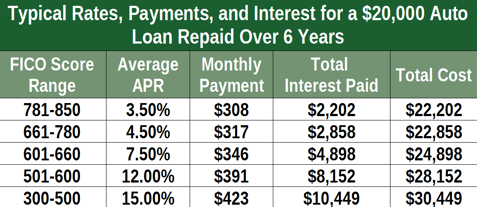
The Credit Report
A credit report has 5 types of information about a consumer:
- Personal identification data– Name, date of birth, social security number, addresses and phone numbers. You want to have only one form of your name listed on your credit report. With the least number of addresses. In terms of credit scoring, having more than one variation of your name will affect your score suggesting instability. Lenders start to think if the consumer is trying to hide from something because of aliases. The most common form is first name, middle initial, and last name.
- Tradelines– These are your accounts like credit cards you have open, student loans, and home loans. This section is the bulk of information influencing your credit score. It is the consumers track record.
- Collections– If you have any account that has been sold to a collection company, this section will show that. The creditor cannot collect or accept money for the debt anymore, but you still owe the debt. When a charge-off turns into a collection, your score could take a hit twice.
- Public records- This section is reserved for bankruptcies and foreclosures. This section also impacts a credit score negatively. Tax liens and judgements used to show under the public records section.
- Inquiries –Requests made by a lender, creditor, or another party to review your credit report.
Types of credit lines
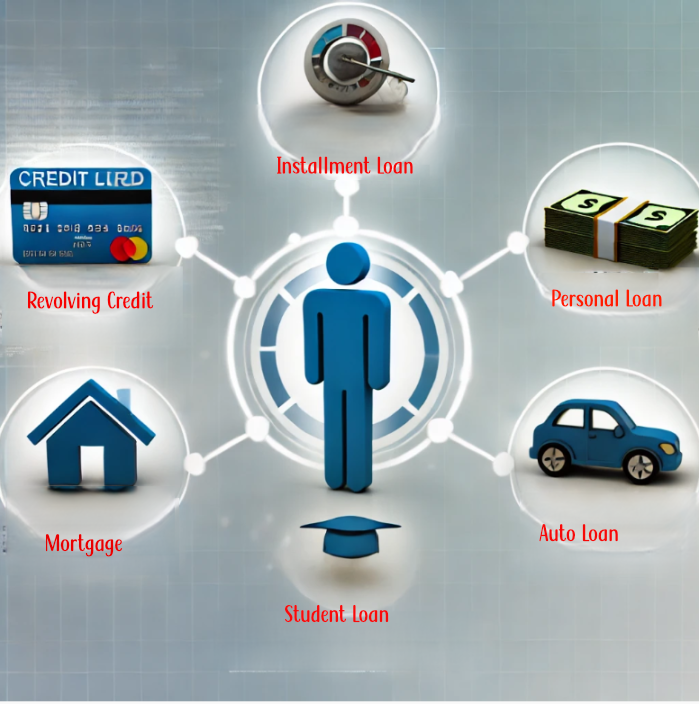
Understanding the different types of credit can help you make more informed financial decisions and choose the right type of credit for your needs.
These are the 3 main types of credit. There are other types but overlap with the 3 main types.
Revolving credit: (e.g., Credit Cards – Visa, Mastercard) You have a credit limit, and you can use up to that limit. You make payments based on the amount you’ve used, and as you pay off your balance, you can borrow again.
Installment credit: (e.g., Auto Loans, Student Loans) you borrow a fixed amount and make regular payments until it’s paid off.
Open Credit: (e.g., Utilities, Charge cards) These are lines of credit where the balance must be paid in full each month. The balance depends on what you use. If you are late, you are charged late fees, and the account is reported to the credit bureaus as late.
So above you see the credit scoring range. You may notice there are different ranges of scores. Always go by the FICO scoring range because it is the standard for consumer credit. The mortgage industry uses a different FICO scoring model. FICO scores are amazingly accurate in determining risk in individuals paying back what they borrow. That’s what it’s all about “risk”. What’s the risk for lenders? They are giving an individual the ability to make purchases with their money, as long as they pay it back. If they can’t pay it back in full, then there will be interest added to the balance. The lower the score, the greater the risk. Higher interest rates compensate for the increased risk.
Credit scores go up and down all the time. Whenever information is added or deleted from your credit file your score will change. However, your score is not calculated daily. The only time it is calculated is when it is pulled. Whatever is in your file at that time will be scored automatically by the computerized mathematical system. If you made a purchase yesterday and tomorrow your file is going to be updated by the credit bureaus. If you were going to apply for a loan, today would be the primetime to apply. Your credit score is going to be higher today, than it is going to be tomorrow. Because the purchase is going to increase the credit utilization. As it goes up, your score goes down.
If the drop puts you into a lower tier of credit score ranges a monthly payment can be a significant difference.
Influencing Factors in Credit Scoring

The there are 5 factors that make up your credit score. But within the factors there are 40 components that add or subtract points from your score. Here are the 5 factors that affect your score:
Payment history- The most influential factor. Consistency with on time payments is going to influence a strong credit score.
Debt load- The amount of credit that has been used divided by the credit limit gives you a percentage. As the percentage increases, the less points you earn. At 30% you begin losing points. The higher it goes more points will be deducted.
The length of credit- How long has your account been open. The longer you have an open account that has perfect payment history the stronger it is. When an account is closed, it stops earning longevity points. And you lose the credit limit for the account. This increases your debt load. You do not want to close an account, and you definitely do not want the lender to close the account due to inactivity. Use your credit cards at least twice every three months to keep your account active.
Types of credit- Lenders want to see that an individual can manage different types of credit.
Inquiries- There are two types of Inquiries, soft and hard. Soft Inquiries is when creditors do a check on their customers. This helps to reduce risk for the lenders. If a they see a customer has begun making late payments with their other accounts, the lender assumes their going to be next. They can take action by reducing the credit limit and letting the customer know that the interest rate has increased. A soft inquiry doesn’t hurt your credit score. On the other hand, a hard inquiry is when consumer submits an application for a credit line. Hard inquiries deduct points and will remain on your credit report for 2 years. But they only impact a credit file for the first year.
Additional Information
If you are shopping around for the best home loan, you are going to see more than one lender or mortgage broker. The same goes for auto financing, you want the best terms you can get. For these situations you will have a timeframe to shop around, and the credit pulls will count as one inquiry. However, that doesn’t apply for applications for revolving credit (credit cards). If you apply for multiple credit cards within a short period, a lot of points will be deducted because the risk of taking on more credit that can be handled, increases.
Statistics have shown that someone who has six or more hard inquires in the past year is 8 times more likely to declare bankruptcy than someone that has no hard inquires in the past year.
As you can probably tell, the algorithm that’s used in calculating credit scores is very complex. Forget about your credit score and focus on paying the balance in full, on time every month and keep your balances under 10%. You will have an excellent credit score anytime your credit is pulled.
How to Effectively Dispute an Inaccurate Debt on Your Credit Report
5

If you are at this point, the inaccurate information you want deleted from your file is being validated. You may have received a letter stating: “Unfortunately, we are unable to remove the disputed information reported on your credit report. To preserve the integrity of the credit reporting system, we are unable to alter or remove valid information reported to the credit reporting agencies.”
What is your next move?
Well, you will now send a letter requesting written proof no matter who you are sending your letter to. But there are different letters that depend on who you are sending the letter to.
The terms “debt validation” and “proof of debt” are related but apply in different contexts and have distinct requirements.
Debt Validation
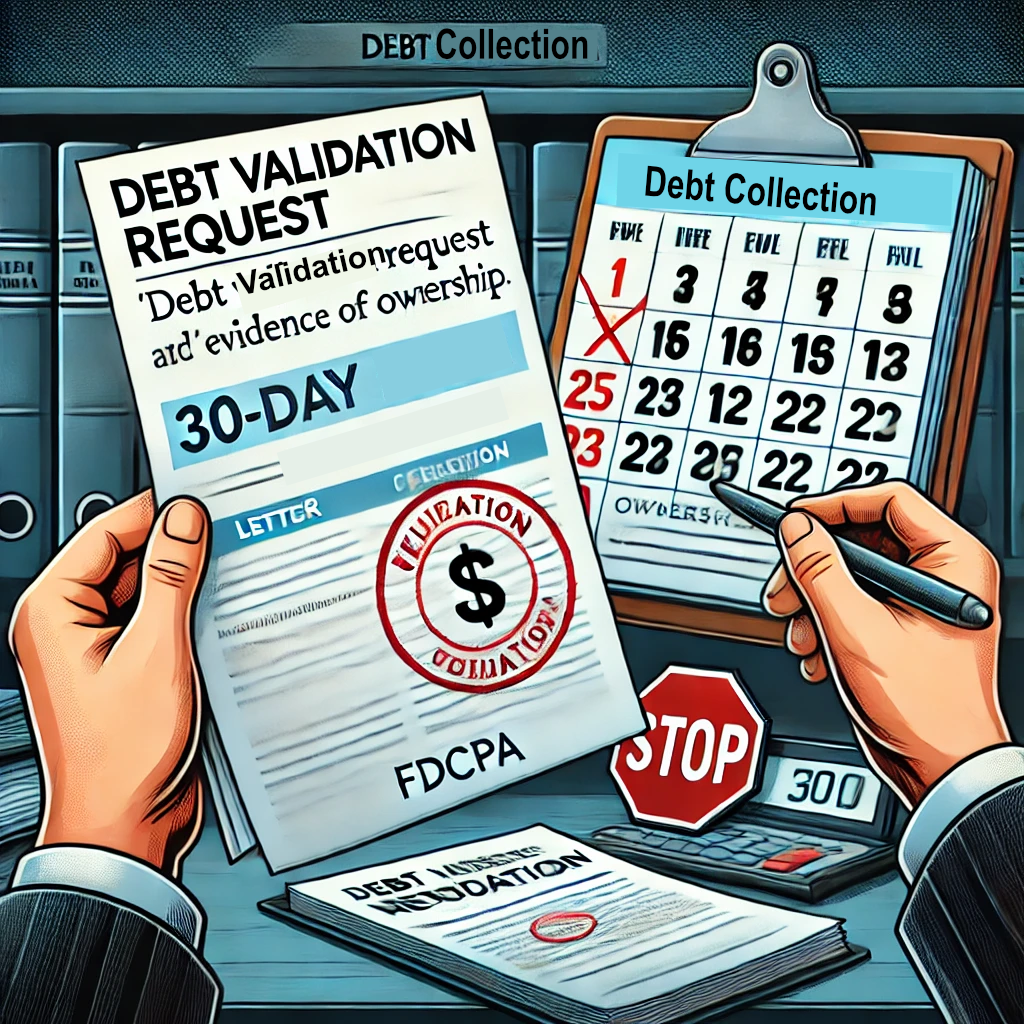
Debt validation applies specifically to debt collectors and is governed by the Fair Debt Collection Practices Act (FDCPA). When a debt collector contacts a consumer about a debt, the consumer has the right to request validation of the debt. The debt collector must provide the following:
- Verification of the Debt: Information about the amount of the debt and the name of the creditor to whom the debt is owed.
- Evidence of Ownership: Proof that the debt collector has the legal right to collect the debt, which typically involves a transfer of the debt from the original creditor to the debt collector.
- Details of the Debt: A statement providing details of the original debt, including the original creditor’s name and the amount owed.
The consumer must request this validation in writing within 30 days of being contacted by the debt collector. The debt collector is required to stop all collection activities until the debt is validated.
Proof of Debt
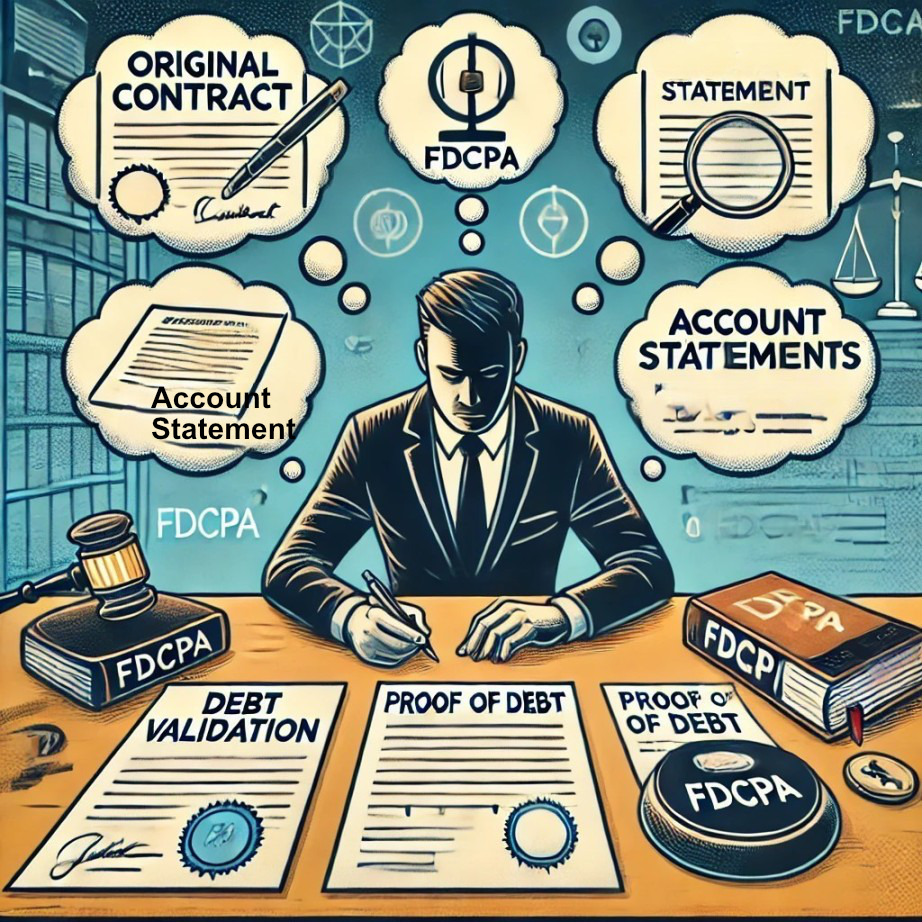
Proof of debt applies to creditors, the original entities that provided the credit or loan. Creditors must provide evidence that the debt is valid and that they have the right to collect it. This typically includes:
- Original Contract or Agreement: A copy of the original agreement or contract that established the debt, showing the debtor’s signature.
- Account Statements: Detailed statements showing the transactions, charges, payments, and balance history.
- Proof of Ownership: Documentation proving that the creditor owns the debt.
Key Differences
Applicability:
- Debt Validation: Applies to debt collectors who are attempting to collect a debt on behalf of another entity.
- Proof of Debt: Applies to creditors, the original lenders or entities that extended the credit.
Legal Basis:
- Debt Validation: Governed by the FDCPA.
- Proof of Debt: It is not governed by any specific act. However, in order for a creditor to establish the legitimacy of the debt, these documents are what will prove legitimacy.
Content of the Request:
- Debt Validation: Focuses on the legitimacy of the debt collector’s right to collect and the basic details of the debt.
- Proof of Debt: Focuses on the complete details and history of the debt, including the original agreement and detailed account statements.
Summary
- Debt Validation: Ensures that the debt collector has the right to collect the debt and that the details they provide are accurate.
- Proof of Debt: Requires the original creditor to provide comprehensive documentation proving that the debt is valid and detailing the debt’s history.
By understanding these differences, you will be able to navigate your rights and obligations when dealing with debt collectors and creditors. When you request debt validation or proof of debt, they are legally bound by that request and cannot ignore it. If any documents are missing, it is not proper validation. You have the right to send a letter to the credit bureau demanding they delete the information.
The Art of Debt Validation: Unveiling Credit Bureau Secrets
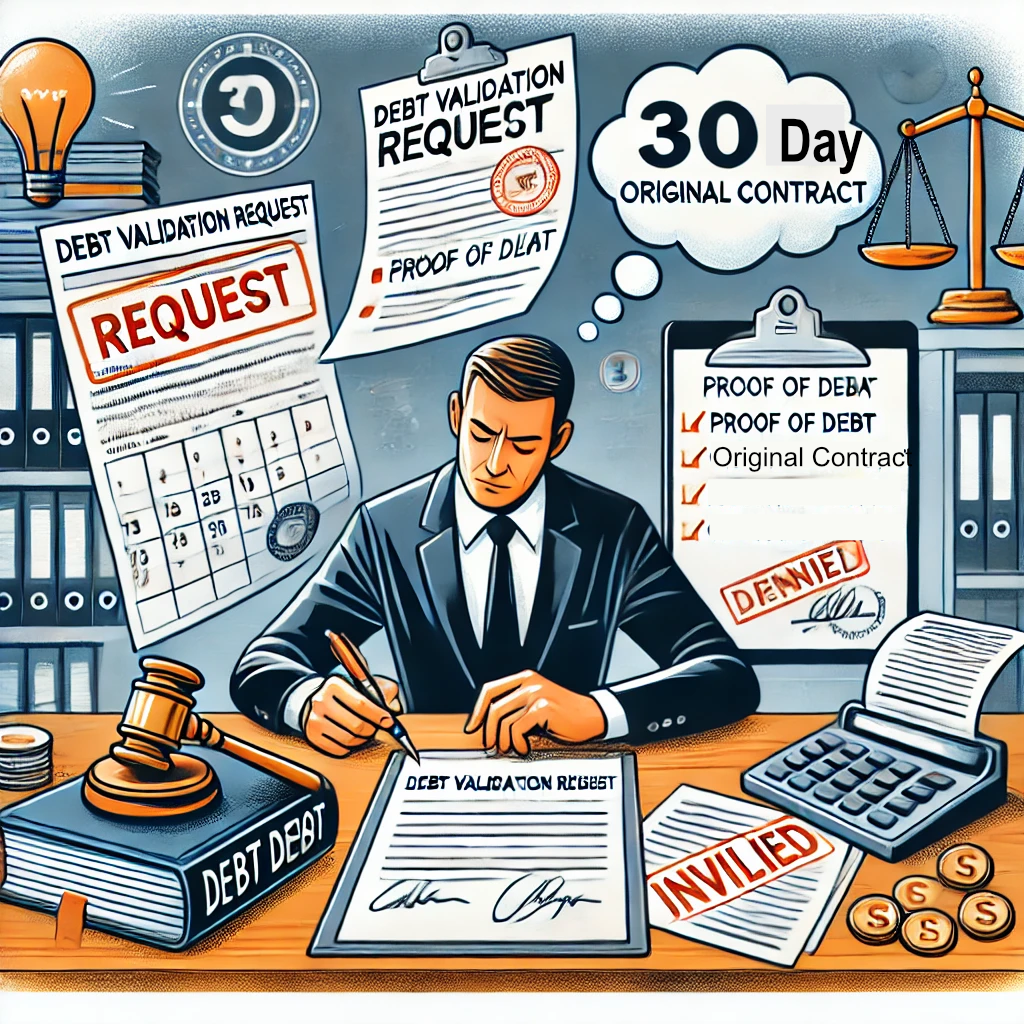
The creditor is not allowed to continue reporting the account to the credit bureaus, they cannot collect any money from you, and they are not allowed to contact you about the debt. With debt validation and proof of debt, you are banking on the fact that the creditor doesn’t have one specific document on hand. The original contract that you signed when you opened the account. Maybe they don’t have the time or inclination to locate your original document that has your signature on it because of the inconvenience.
Medical offices keep excellent records. Some creditors do and some do not. If it is a new account, they probably will have no trouble locating the document. However, if the account is established, paper records may be stored offsite, and locating the document will take time.
If you are in good standing with the creditor, it would make more sense to delete the information and keep their customer, you, happy. However, if you are in bad standing with the creditor, they will ensure they provide proof because you have not upheld your end of the agreement. And they are probably not too happy with the situation.
If it is a debt collector, the older the debt the less likely the debt collector is going to have the original credit agreement. Generally, as debts are transferred or sold, maintaining complete and accurate records can become more challenging.
The chances of a debt collector having a copy of the original credit agreement for the debtor can vary depending on several factors including the age of the debt, the policies of the creditor, and the practices of the debt collection agency. Here are a few considerations:
- Age of Debt: Older debts are less likely to have the original credit agreement readily available. As debts are sold and transferred between different collectors, documentation may be lost or not transferred completely.
- Type of Debt: Certain types of debt, like credit card debt, may not involve a detailed “credit agreement” as one might expect with a mortgage or a car loan. Instead, they might be governed by the terms of service agreed upon when the account was opened, which might be updated periodically.
- Creditor Policies: Some creditors maintain thorough records and transfer these to debt collectors when selling the debt. Others may not keep detailed records or may not transfer all documents to the agency.
- Collection Agency Practices: Some debt collectors maintain comprehensive records and can easily access original agreements, while others may not prioritize keeping detailed files.
- Legal Requirements: Depending on the jurisdiction, there may be legal requirements for debt collectors to retain and provide original credit agreements upon request, particularly if the debtor disputes the debt or requests verification.
How to Challenge Credit Bureaus and Win the Credit Repair Game
You know that credit repair is not a one size fits all. Your situation may have a better outcome by sending letters to creditors. I am going to stick to the general steps. So, we are going to send the next letter to the credit bureaus that show the inaccurate information. We have sent them a letter requesting an investigation be done on the matter. Knowing that they do not investigate, and they do not look over any documentation. You have been keeping track of the letters you have sent. So, you know what date you sent a letter and the date in which they received it.
We expected them to verify the information and send you a response letter back. They are stalling. Trying to deflate your balloon. This tactic works well for them. A lot of people would have quit by now. Who can blame them? It’s frustrating .
They are not expecting you to send a letter back. We want to see what happens when you call B.S. on them.
They should have provided you with the specifics of their investigation. But it was not requested and they are not obligated to.
So let’s request to have their method of verification because you do not believe them. Send this letter certified mail, because they are now obligated to provide you with the specifics. If you do not receive the receipt that shows the letter was signed for, they can say they never received your letter. “It was lost in the mail.”
They now know that they need to provide specific information to you. What determined the information to be valid? What documents were reviewed? You want to know the exact steps they took to verify the information. Who was the investigator? You need their name and contact information so you can communicate with them.
The credit bureaus do not what to give written details of their investigation and hand them over to anyone. It is not like the public doesn’t know. But they cannot lie and write a false report. Stating that they spoke to the furnisher and had them pull out their records and reviewed documents. They can’t do that. That would be a lie and in writing.
And they also do not want to write what actually occurred and hand it over to a consumer. But they are required to because you requested it. They do not want to tell you that they outsourced the dispute to the Philippines, nor do they want you calling their agent and the agent saying something they are not supposed to. In fact, the vendor’s do not have phones at their workstations with the disputes that are outsourced.
Their other option is to delete the information altogether, and the problem goes away.
Sample of Method of Verification
Sample Letter for Incomplete Debt Validation
Disputing Negative Items on Your Credit Report
4
Understanding the Impact of Closed Accounts on Your Credit Score

On your credit report, you will find both open and closed accounts. Closed accounts can affect your credit score in several ways. Here’s how:
When an account is closed, the credit limit on that account is deducted from your total available credit. This increases your credit utilization ratio, which is the percentage of the amount of credit that you’re using from what is available to use.
For example, if you have three credit cards. Each has a limit of $4,000. The total available credit is $12,000. If you have used $4,000 of the $12,000, your credit utilization is 33%.
If one card with a $4,000 limit is closed, your total available credit drops to $8,000. Your credit utilization jumps to 50%, which will negatively impact your credit score. Experts recommend keeping your credit utilization under 10%. Because you gain points when your score is calculated. 30% is the point when your score will start losing points and the higher the percentage goes, the more point you lose points.
In addition to your credit cards being scored altogether, they are also scored individually. The balance that will earn the most points is $0. However, if there is a $0 on a closed account, it will negatively impact your credit. Closed accounts that read “paid as agreed” is how the status on a closed account should read.
How Credit Utilization and Account Longevity Influence your Credit Score
When an account closes, in addition to credit utilization, the average length of a consumer’s credit history shortens. The length of credit history is a significant factor in determining your credit score. It contributes 15% to your overall FICO credit score. Here’s a breakdown of how this aspect is evaluated:
- Age of Accounts: Credit scoring models consider the age of your oldest credit account, the age of your newest credit account, and the average age of all your accounts. A longer credit history with great payment history generally indicates more experience managing credit, which positively impacts your score.
- Length of Time Accounts Have Been Open: The longer your accounts have been open and in good standing, the better. It shows a history of responsible credit use.
- Time Since Recent Account Activity: Credit scoring models also consider how long it has been since you used each of your accounts. Regular, responsible use of credit is viewed favorably.
The length of credit history accounts for 15% and credit utilization accounts for 30%. These two factors make up almost half of your credit score.
Implications of a Closed Account
A lender will look at a consumer’s credit score to help determine if the applicant is a high risk. In addition, to looking at a credit score, lenders will review a consumer’s credit report. Within your credit report there is information that are red flags for lenders. As an example, if a credit report states that the consumer is working with a credit counseling service or a debt management company. It tells potential lenders that the consumer cannot manage their money. Lenders see this as bad as Chapter 13 bankruptcy.
An account can be closed by the consumer or by the creditor. If your account is closed, you want to be the one who closes the account. A creditor closing an account does not look good to potential lenders. It is a red flag, lenders might interpret that the creditor closed the account due to the consumer’s financial instability or inability to manage credit responsibly. I
To avoid having an account closed due to inactivity, you only need to use your credit card twice every 3 months to keep it active. And the purchase doesn’t need to be expensive. It could be as small as a pack of gum.
A closed account stops earning longevity points, that is what you want, longevity with excellent payment history. That builds strong credit. And you get more points for maintaining a credit account for a long time. However, if a closed account is in good standing with the creditor. It will still be beneficial because it shows a record of timely payments. Your credit payment history accounts for 35% of your credit score. It’s the most influential factor.
It will also help with the age of accounts because remember the scoring model considers the age of the newest account, the age of the oldest account is, and the average age of all your accounts is also considered. Closed accounts will contribute to that factor.
A closed account in good standing reflects well on your ability to manage credit responsibly. Future lenders view this positively as it indicates that you have a history of honoring your credit obligations, even if the account is no longer active.
When to Consider Closing an Account
While it’s generally advisable to keep credit accounts open, there are situations where closing an account might be beneficial. As an example, if you have an excessive number of credit cards (e.g., 10), closing a few may be a good idea to maintain a manageable amount of credit. A potential lender doesn’t know how you’ll be able to handle a new line of credit. Everyone has that point where it’s too overwhelming. Having too much credit is not a good thing for potential lenders to see. Three credit cards earns the most points; having more will negatively impact your score. This is just one of many characteristics that determines your credit score.

How to Close a Credit Account Properly:
- Pay Off the Balance: Ensure that the account balance is paid as agreed.
- Notify the Creditor: Contact the creditor to request the account closure.
- Confirm Closure: Obtain a written confirmation that the account has been closed.
- Monitor Your Credit Report: Check your credit report to ensure the account is marked as “closed by consumer” if you initiated the closure.
Handling Negative Items on Closed Accounts

If you have a closed account that is paid off but have negative items, such as a balance showing that you already paid off and late payments. This account is hurting your score and will look bad when a potential lender reads your credit report. This type of account needs to go.
But you never want to write that the balance is wrong. What do you want to write? “The account is reporting false information.” Whatever the issue is, reference it as “an account that is reporting false information”. In which case you have the right to demand deletion.
That is a true statement that is based on the law. Don’t write about your struggles. Don’t send a goodwill letter and risk the chance of saying too much and admitting the account to be yours.
Your dispute letter is not disputing the account or negative item as being yours because that could be a lie. Your letter is disputing the fact that false information was reported and posted on your report. You see any information that is added to a consumer’s credit file must be verified as accurate.
In other words, if I open up a credit line. The creditor is going to report the account to the credit bureau. When the credit bureau receives notice of a new account. They must verify that the consumer did indeed open up a new account. Before it is added to their file.
The law doesn’t say that derogatory accounts must remain on your credit report for a period of 7 years. It only limits the amount of time they can be visible on your credit report. So, removing derogatory accounts is 100% legal.
Take a look at this Target account from my reports. There are 3 columns, each one represents a different credit bureau. The account is paid off and closed. You can see that this account has 2 late payments that occurred in 2018. They hurt my score whenever it is calculated. Also, the account was closed by the creditor. Remember that is not good for potential lenders to see.
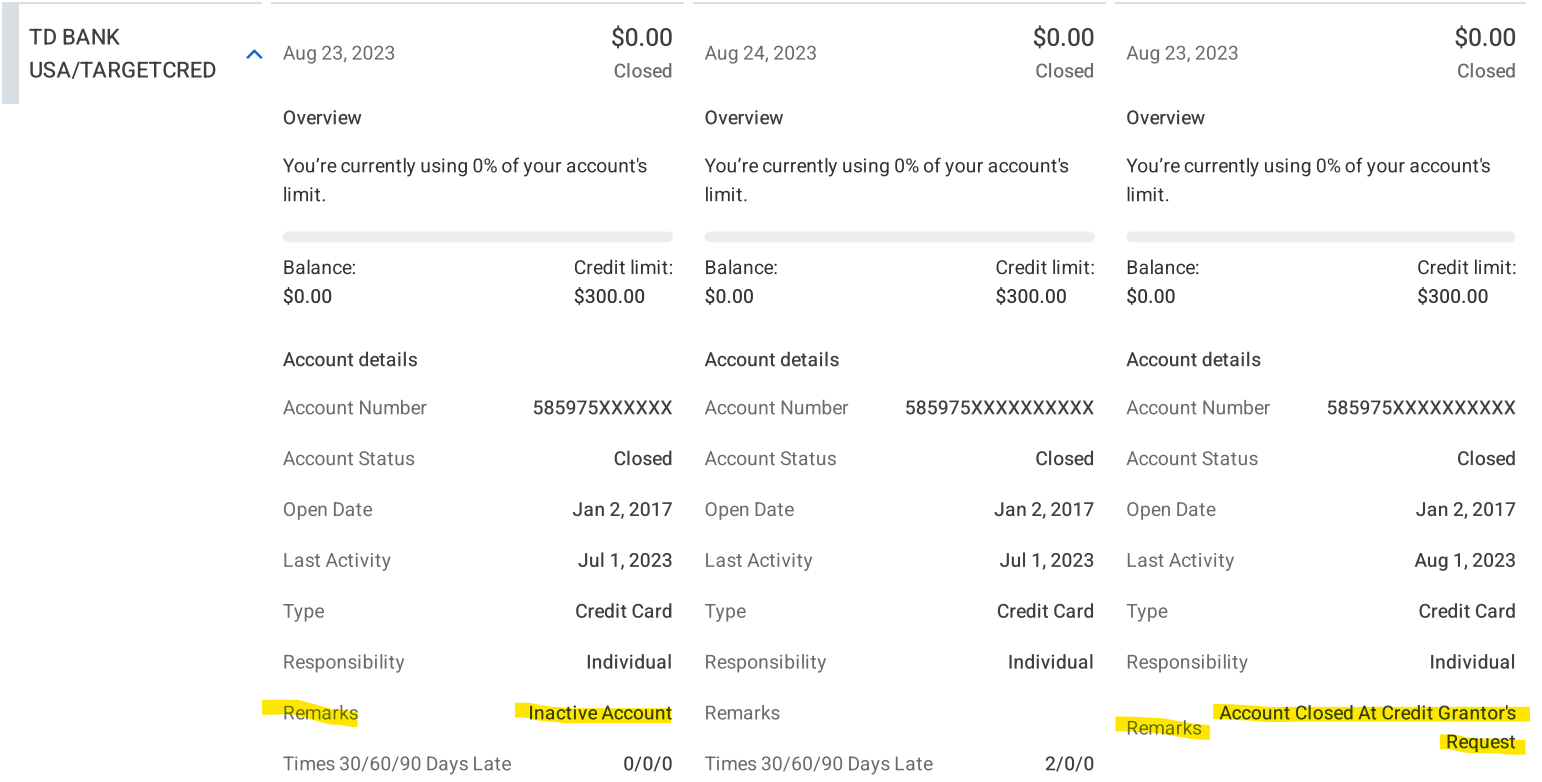
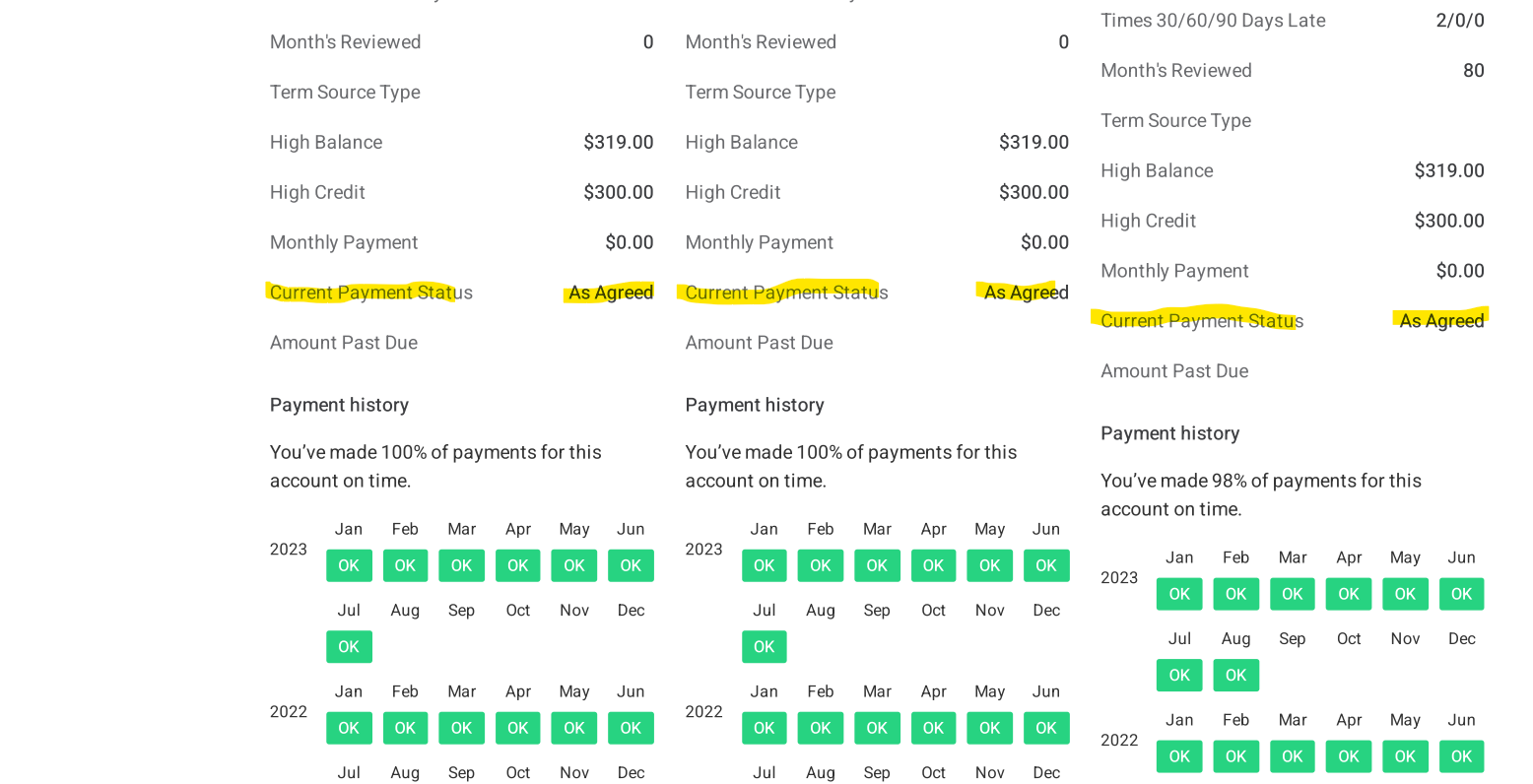

The payment status is “as agreed”. That is what you want the payment status on closed accounts to read. The payment history is almost perfect. That will help when my score is calculated. Because of the payment history, I want to keep this account listed.
If I was going to have this account deleted, I would send the letter to the credit bureau first. The rule of thumb is to challenge the credit bureaus first and creditors second.
Remember the previous step we sent the letter to the credit bureau. Assuming we received a verification letter. We would send a letter to the creditor next because they reported the information. They will need to prove it or delete it. Those are the only choices they have.
You want your letter to depict you as an honest person who is astonished to find an error on your credit report. And because the law allows you to exercise your rights and demand an account with false information posted, be deleted. That is what the letter is instructing them to do. Because your credit is very important to you and don’t want your credit to be negatively impacted. Versus someone who hired a service to remove a list of derogatory items.
letter to creditor to remove negative item from report
Identifying and Correcting Errors in Your Credit Report
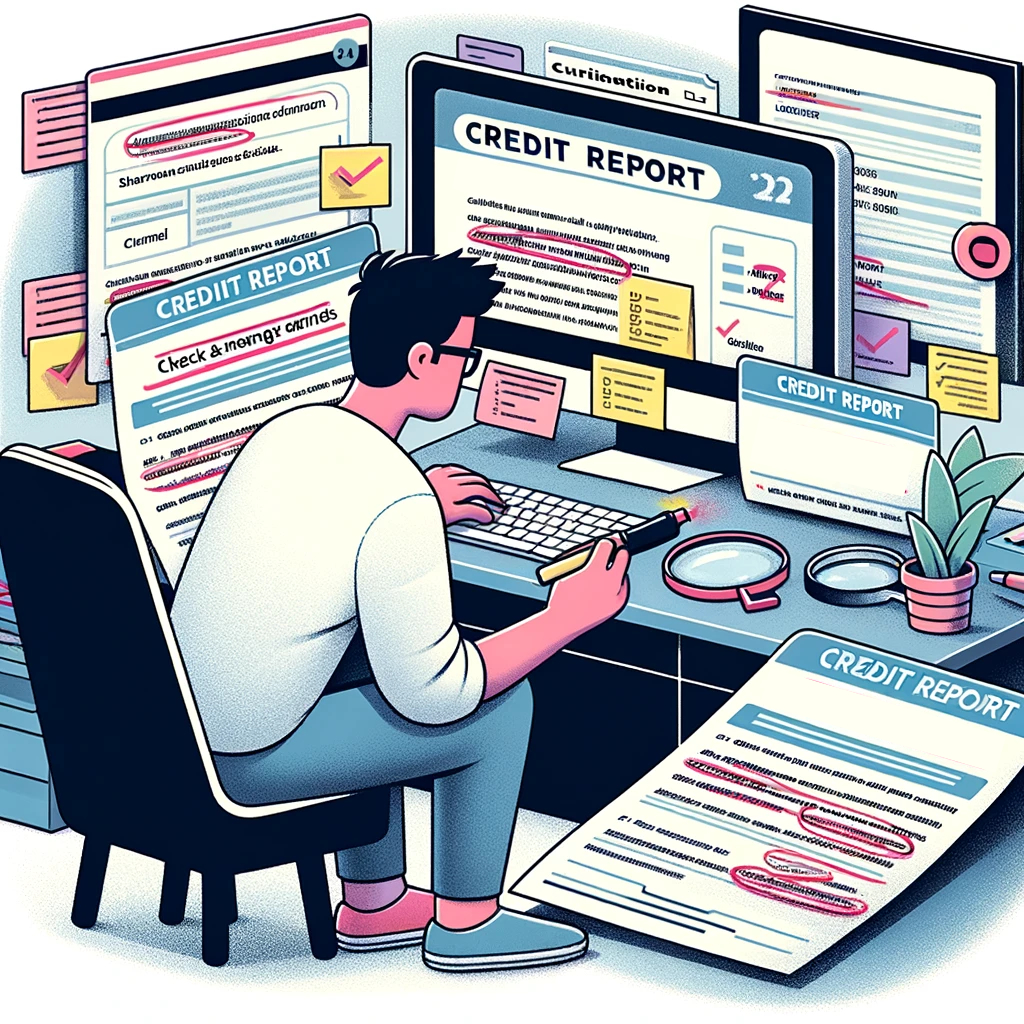
Is there anything wrong with the account, maybe there’s a zero that should be the letter O. Maybe the date is wrong. A common error is a balance showing on a paid off account. When the creditor sells an account, they don’t own the account and cannot collect money on the account anymore. The balance should show $0.
The Target account shows $0 for the balance. The fact is I will keep the Target account because the payment history will help my credit score.
But I will use it as an example. If I wanted to have it deleted because of the two 30-days late payments, I would look for a factual error.
You want to look for any false information. In a previous step you had chosen a form of your legal name you were going to use going forward. Any other names listed on your credit report; you had them deleted.
Check to see what name is tied to the account with the negative item. If the name tied to the account is not your chosen name, the information on the account is false. You can demand deletion of the account.
You also had addresses removed. What address is the account tied to. If it is tied to an address that was deleted, the information is is now false.
When reviewing your three credit reports, it is important to directly compare them side by side to ensure that they are accurate and consistent. Discrepancies may occur during this examination. Let’s use the target account as an example.
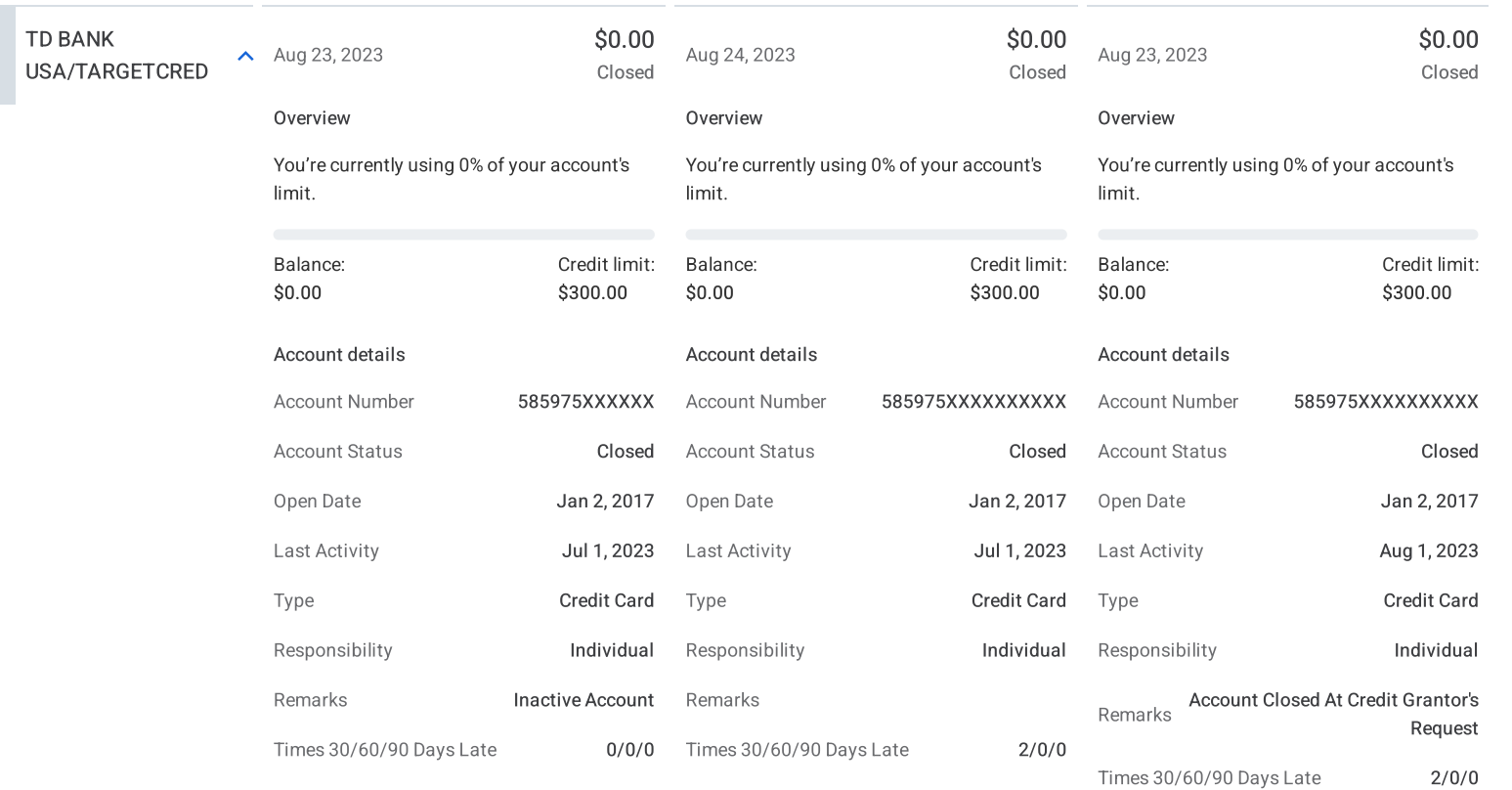

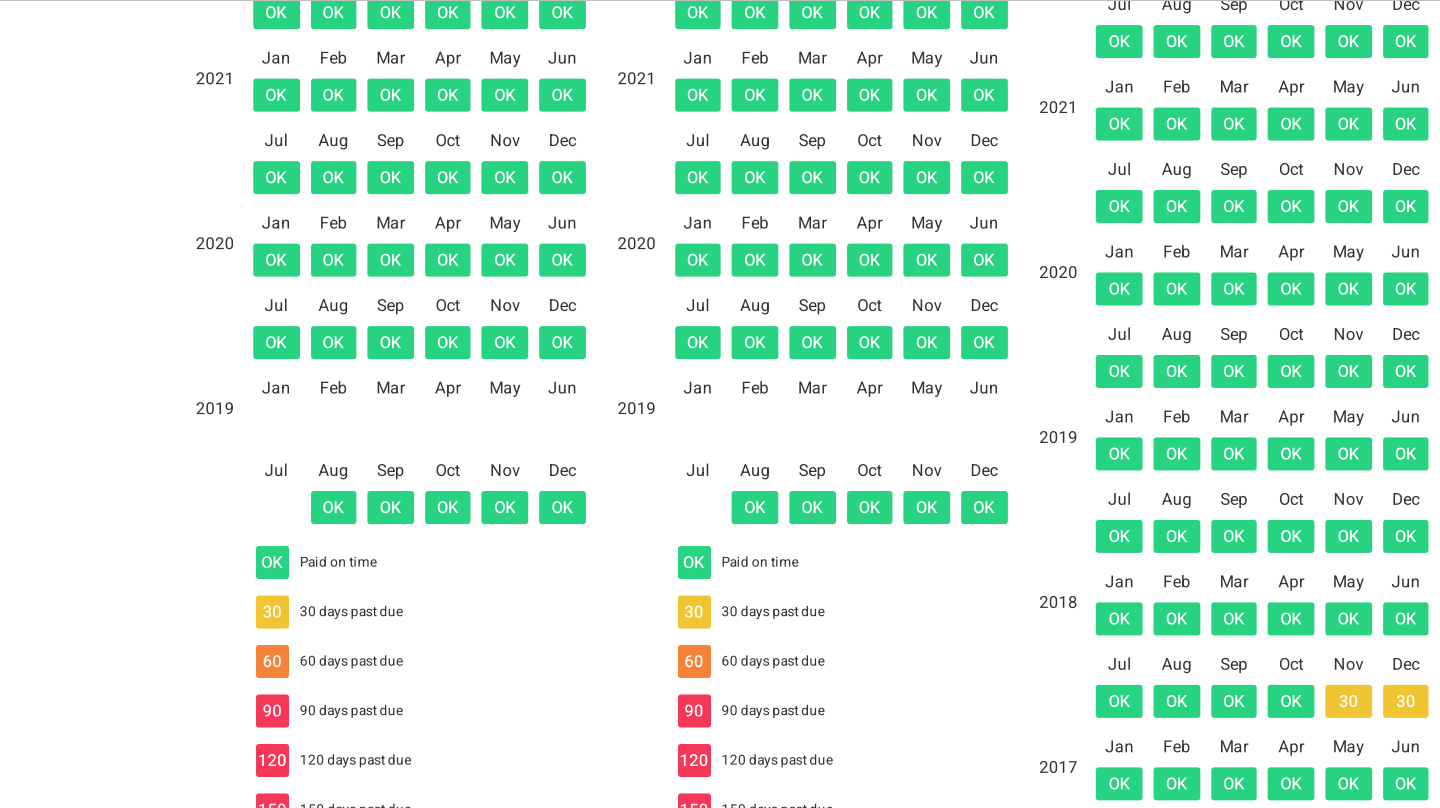
Again, each column is a different credit bureau. The creditor is Target, same account, same creditor. The credit bureaus will not know anything that isn’t reported to them. Because of this, I can understand if Experian didn’t show my Target account on their report. I can make the assumption that the creditor reports only to Equifax and TransUnion.
However, if the creditor is reporting to all three credit bureaus, as Target does, I expect the information to be the same across the board. If Target reported to TransUnion and Equifax that; “I had made 100% of payments for this account on time”. What should I expect Target to report to Experian? I expect to see the same post, right?
Experian shows that Target reported that; “I had made 98% of payments for this account on time”. This my friend is inconsistent reporting. This leads to discrepancies in my credit reports, which is going to affect my credit score and lending decisions. Since it is the same account only one of the two different statements can be true. If I didn’t compare the three reports side by side, I never would have caught this error.
Credit repair is not a straight line. You may need to adjust to make sense for your situation. For example, in this step we are sending a letter to the creditor. But for this discrepancy, I would send a letter to the credit bureaus before I send a letter to the creditor. Because the creditor could make the correction needed and then tell the credit bureaus to make the change in their records.
When I provide screenshot copies of the account from my report and point out that contradictory statements have been reported and posted to my file. I demand the account be deleted. There isn’t any proof that can be provided that will make the contradictory statements true at the same time. I am sure that there is a simple explanation why this error occurred.
But that isn’t the issue anymore, the problem is that the report is misleading for potential lenders. The quick and easy option is to delete the account. And the creditor won’t have to be bothered with this error.
It’s a closed, paid off account. It does not hurt the creditor at all if the credit bureaus delete to the account. Whereas this does hurt my credit by having it remain.
In reality, the payment history on the account outweighs the two 30-days late payments. So, I am going to leave this account as is.
You will have twists and turns that don’t follow the fundamental steps of the disputing process. A step might be sending the letter the furnisher, but a situation may have a better chance of success if the letter is sent to the credit bureau.
Back to the step, in the letter I would include screenshots from the three reports that show the contradictory statements, printed out so I can place into the envelope before sealing it. Pointing out the inconsistent reporting in the letter and demand deletion of the account reporting false information.
By this time the letter has been sent and received by the creditor. Generally, the creditor has the proof of verification somewhere in their records. The question is, does the creditor have the time to search their records for verification? Time is money for them. They may not have the time to go searching, or it might be too much of a hassle for them. Deleting the information will be less of an inconvenience.
Now your credit history with the creditor will come into play. If you have a great history, it would be better to keep you happy and delete the information. That could result in you applying and opening a new account, using credit, and the creditor makes money in the long run.
If you have multiple late payments on the account, expect the creditor to dig through their records and find the proof. Your next move is to wait for a response to your letter.
Letter for Closed Paid Off Account
Handling Late Payments on An Open Account
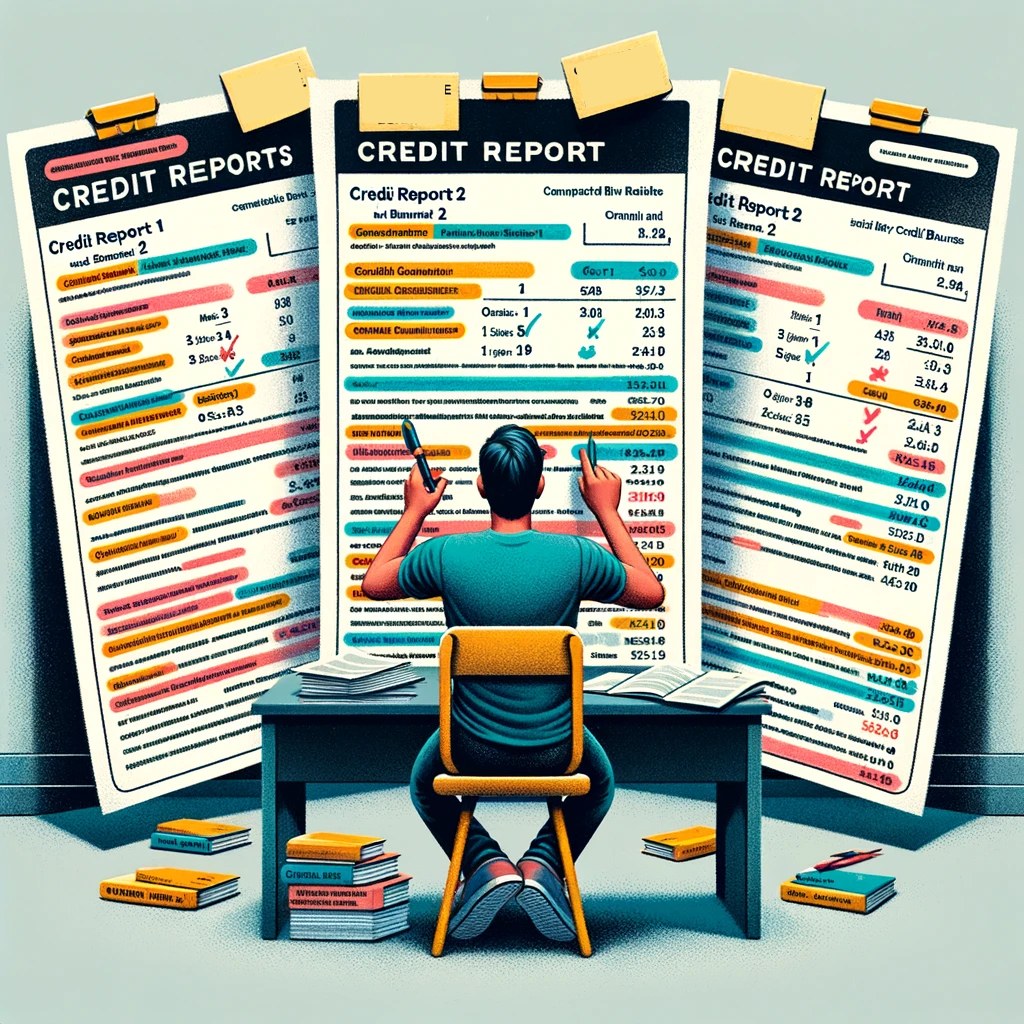
Make sure you are not behind on any credit card or loan payments before attempting to remove late payments from an active account. Prioritize catching up on any outstanding payments and maintaining a regular schedule of paying on time. This step is essential as it becomes challenging to dispute past late payments if you continue to be late in your current payments.
Compare all three reports against each other and check for any discrepancies within the three reports, like I did above, before you send any letters.
If you have one late payment that is older than two years, and the rest of your credit is perfect, you could leave it alone. Because it isn’t hurting your score as it did the first two years. The longer it has been since the negative event occurred, the less and less damage it will do.
But if you want it gone, if you have proof to show you weren’t late, get it. I know the burden of proof is on the creditor, but honestly the burden of proof is on both parties. The proof can be the bank statement showing the funds being withdrawn.
If you lack evidence and have a single late payment with an otherwise flawless report. It is out of character for you. Your report indicates that this late payment is an anomaly. You do not typically have a track record of late payments.
The obstacle you face is the one who reads your letter. What if the representative is the type that dictates the law to borrowers? The law says that inaccurate data cannot be added to a consumer’s file. And accurate data cannot be deleted. Therefore, the information on file must be accurate.
To ensure your letter reaches the appropriate person, consider identifying the individual responsible for handling customer complaints.
- You can locate this information on the company’s website,
- Conduct a Google search using the company name + “file a complaint,”
- Or contact their customer service hotline for assistance.
Once you find the name, address the letter to that specific individual, ensuring you spell their name correctly. Avoid using generic salutations like “Dear Sir or Madam.” If the name is unavailable, you can opt for “Dear Executive.” If your handwriting is clear, consider writing the letter by hand.
The letter you send should be non-threatening and complimentary, expressing appreciation for their service. As a loyal customer, you anticipate continuing to support their business. As you conclude the letter, make it clear to the recipient that your business dealings with them are paused until the inaccurate information is deleted.
Again, your credit history will come into play. If you’re a long-time customer with a good history, it makes more sense to delete the late payment to keep a loyal customer and the creditor is able to keep your credit line open for use, everyone wins.
Unfortunately, I cannot guarantee this outcome. If you are denied, that’s fine, move onto the next step. If the creditor is Capitol One, challenge the late payment with the credit bureaus instead. Because Capitol one will not delete a late payment.
Multiple Late Payments And Covid

If you experienced late payments during the pandemic due to illness or job impact, the CARES Act might have prevented these from being reported. A legal clause could be applicable in this context. Below is a sample letter for such circumstances.
This letter will be directed to the credit bureaus responsible for listing the late payments on your report. It is advisable to send this letter via certified mail to obtain a receipt upon their acknowledgment of receiving and signing for it. The bureaus are required to furnish you with proof within 45 days. Once they acknowledge receipt by signing for it, they are legally bound to address it and cannot claim they did not receive it. Keeping the receipt of their signature handy will be beneficial if needed.
Tips for deleting late payments
- When addressing multiple late payments: Dispute one account at a time per credit bureau if you have late payments on several accounts.
- Maintain professionalism and politeness: Ensure your letters are professional and courteous.
- Use friendly language: End your letter with a warm closing like “Thank you in advance” and start with a friendly greeting such as “I hope you are well.
- Providing documentation to credit bureaus: Update your personal information and include three to five identification documents displaying your correct name and address to improve the chances of deletion. It’s been proven by credit repair businesses that including several pieces of ID helps obtain the deletion.
- Organize your correspondence: Create a system, like a dedicated folder on your computer, to store all your communications, relevant documents, and screenshot images in one place.
A Comprehensive Guide to Disputing Derogatory Items with Credit Bureaus
Introduction

Remember this word Frivolous, it means nonsense. If the credit bureaus can determine a dispute is frivolous, they are not required to do anything. That’s their focus because they are just businesses trying to make a profit like any other business. Businesses try to reduce their expenses for many reasons. One of those reasons is to increase the profit margin.
Consumers are not the credit bureaus’ customers. We do not pay their bills. The “furnishers” do. They are the credit bureaus’, main concern. They bring in more revenue for them than any other areas of their business. Furnishers are the banks, lenders, and creditors. The only concern towards consumers is how can they reduce the cost of investigations.
The Reality of Credit Bureaus
Unless you are wealthy, consumers cannot avoid having a credit history. And we have no say in whether our information is included in the credit bureaus’ databases. We cannot take our information and go somewhere else with it.
Whereas the furnisher can switch between the credit bureaus if they want. Reporting to the credit bureaus cost creditors money. Equifax does not want to lose a creditor to TransUnion. Which can happen if a credit bureau conducts thorough investigations.
The credit bureaus blame credit repair businesses as the reason for their careless investigations. They say that credit repair companies generate frivolous disputes. The make promises of removing valid negative information from consumers reports. About 30% of credit disputes involve credit repair businesses, but they assume every dispute is like this, trying to remove valid negative information.
They know very well you can’t assume every dispute involves a credit repair business. And they do not all try to remove valid negative information. But that still doesn’t explain why they conduct meaningless investigations. It might be a fraction of the reason why, but the real reason is because they are too expensive and undermine their paying customers efforts to collect money from borrowers
Credit bureaus don’t prioritize consumers because credit disputes are a business expense. They are spending money on people who are not their customers.
Conducting real investigations could harm furnishers efforts to collect debts from people. In other words, investigating disputes could reveal that some debts are incorrect or unfair, making it harder for them to collect those debts.
Careless investigations reduce the cost burden of investigations. And they don’t ruin the chances of furnishers collecting their money. They are going to keep their paying customers happy rather that help the consumer. Whatever the furnisher’s say goes.
The Fair Credit Reporting Act (FCRA)
 The Fair Credit Reporting Act was passed in 1970 to address several issues related to consumer credit information. One of the issues being accuracy. It’s supposed to promote the accuracy, fairness, and privacy of consumer information contained in the files of credit bureaus.
The Fair Credit Reporting Act was passed in 1970 to address several issues related to consumer credit information. One of the issues being accuracy. It’s supposed to promote the accuracy, fairness, and privacy of consumer information contained in the files of credit bureaus.
Here are reasons an account can be deleted:
- Incorrectly reporting an account that does not belong to you.
- Incorrectly reporting a late payment.
- Inaccurate reporting of the account date.
- Reporting an outdated negative account.
- Incomplete reporting due to missing information.
- Reporting information that cannot be verified.
Important Facts – 54 Years Later:
- 79% of credit reports contain errors.
- 54% include personal information that is incorrect.
- 22% of reports have loans that were listed twice.
- 8% of reports were missing positive credit information that boosts credit scores.
6 million Americans have errors on their credit reports. Not everyone is disputing errors. I would make a bet that majority of them don’t even know that there is an error. Let’s say only 3 million requested disputes. That is a lot of money. Let’s say half of that resulted in valid errors and needed to be deleted. Thats a lot of money furnishers are not going to be able to collect. This may seem hopeless, but this information can be used to your advantage. You now know that they do not conduct a thorough investigation. That information is going to come in handy later on.
Understanding the Law
 Let’s talk about the t law. Credit reports must be 100% accurate. Accurate information cannot be removed from a consumer’s file. People are not perfect, and the credit bureaus employ a lot of people. Of course, errors are going to happen now and again, that’s understandable. The FCRA allows consumers a way to fix the errors that have been made. One thing to remember is that a consumer must exercise their rights. It’s the only way to hold the credit bureaus accountable.
Let’s talk about the t law. Credit reports must be 100% accurate. Accurate information cannot be removed from a consumer’s file. People are not perfect, and the credit bureaus employ a lot of people. Of course, errors are going to happen now and again, that’s understandable. The FCRA allows consumers a way to fix the errors that have been made. One thing to remember is that a consumer must exercise their rights. It’s the only way to hold the credit bureaus accountable.
The FCRA says the credit bureaus are required by law to investigate consumer disputes submitted in writing within 30 days plus mail time. The FCRA has not been updated to include telephone or online disputing. Assume that you lose your rights if you dispute any other way than USPS mail. Disputing by phone or online puts you in harm’s way in terms of your dispute being labeled as frivolous.
Ignoring a valid dispute letter is a violation for the credit bureaus. But if the credit bureaus determine your dispute to be frivolous or nonsense, they are not required to investigate.
What Makes a Dispute Frivolous?
- You want your letter to be clear and easy to understand.
- You want to write it in a genuine and honest way.
- You want your letter to sound believable.
- You want it to be based on facts that can be verified.
- You want it to be honest and accurate.
- You want it to be legally strong and valid.
The E-OSCAR System
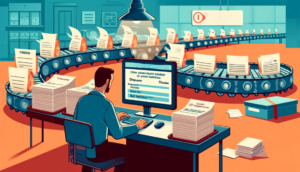 In every business a common goal is efficiency. Which is streamlining operations to reduce cost and increase productivity.
In every business a common goal is efficiency. Which is streamlining operations to reduce cost and increase productivity.
In 1993, efficiency was rolling out E-OSCAR (Electronic Online Solution for Complete and Accurate Reporting). It was developed and implemented by the credit bureaus so that they can eliminate disputes as fast as possible. When you use online disputing, it’s completely automated. The only difference between online disputing and using U.S. mail is live employees reads the letters.
Both creditors and credit bureaus like the current system because it lets them spend only a few seconds on a dispute instead of taking the time needed to properly resolve it. Employees and vendors must meet quotas. No one is focused on getting to the bottom of the dispute. The investigator should be focused on the facts with an unbiased opinion. Here is a nasty secret, the credit bureaus do not investigate. They receive information and even though they are required to validate any information that they add to any file, in reality, the amount of information that is processed each month would bring would destroy any efficiency they have.
What Happens During an Investigation
Are you thinking, reviewing documents, researching facts, interviewing witnesses, or comparing handwriting? Calling the consumer to talk to about the issue and get their side of the dispute. Well, then wait until you read what goes on.
The Investigation Process
 There’s no incentive for conducting a true investigation. The role of the credit bureau employees assigned to credit reporting disputes have very restricted duties and responsibilities. The credit bureau employee will receive the dispute letter and read it, as well as review any supporting documentation. They will get a sense of the dispute.
There’s no incentive for conducting a true investigation. The role of the credit bureau employees assigned to credit reporting disputes have very restricted duties and responsibilities. The credit bureau employee will receive the dispute letter and read it, as well as review any supporting documentation. They will get a sense of the dispute.
The credit reporting industry uses a standardized electronic form: Consumer Dispute Verification form. It has a few items on it. Identifying information about the consumer in the credit bureau’s file; Place to enter a dispute code; Place for comments. Enough space for a 1-2 sentence of commentary.
The employee has 26 dispute codes to choose from. They are choosing the dispute code that best matches what they just read in the consumers letter; Of the 26 dispute codes, 5 of them are used for the vast majority of disputes.
- Not his/hers
- Disputes present/previous Account Status/History
- Claims Inaccurate Information. Did not provide specific dispute
- Disputes amounts
- Claims account closed by consumer
Let me resay that. The consumer’s detailed letters are summarized into a 2-to-3-digit code. No attachments can be sent electronically. The employee sends the electronic form to the furnisher. That officially initiates the investigation.
The dispute system is dependent on the dispute codes. When the furnisher receives the dispute form, the furnisher knows it means to investigate. Do you really think that the creditor is really going back into their records to prove the information is verified as being accurate? After they see the dispute code. What are they even supposed to investigate if they only have the electronic form to work off of?
The majority of disputes end with the furnisher verifying the presence of the disputed information without investigating the dispute itself. They don’t examine the details, review documents, or speak with consumers regarding the dispute. Instead, the furnishers just check that the information on the Automated Credit Dispute Verification form matches their own computer records, and then confirm the disputed information to the credit bureaus is verified as accurate.
And then the verified letter is sent to the consumer. Stating that the disputed item has been verified as accurate. And because the removal or deletion of accurate information is against the law. The information will remain.
All of a sudden, the law is brought up. Where was the law during the process? What is anybody going to do about it anyway? Who is going to know?
Well, now you know, and you can work with it. It’s not going to get better. Two reasons why consumer disputes outcomes will not be fair:
- Consumer disputes are a business expense to the bureaus and to increase the business profit margin they must reduce business expenses.
- Conducting a reasonable investigation has the potential to of hurting their customer’s business of collecting debts from borrowers.
What can anyone do?
Well, use this information to work for you. The credit bureaus do not have free reign. They have a lot of room to maneuver, but when the consumer exercises their rights, they have to follow the law. They cannot say that the information is verified and leave it at that. If they allegedly did what they say they did, then they can prove it.
Be prepared to send multiple dispute letters because in credit repair, sometimes you hit a point where nothing works. And the credit bureaus try to stall by sending the same response letter, hoping that consumer will give up and move on.
The response letters do not include any specifics about the investigation that took place. Probably because they don’t want the consumer to know what went on. They are only required by law to provide details when the consumer requests it.
I am jumping the gun on the process, we are not there yet. We are discussing the first round right now. This letter is just a request for investigation. But during the process you will have your chance to demand details of the investigation.
Some Tips to Help Along the Way

- If you have receipts or billing and payoff statements to support your dispute, include them with your letter.
- Avoid explaining too much in the letter itself. Sympathy is not part of the credit bureaus vocabulary. Explanations only admit to the error being true and accurate. Let supporting documentation do the explaining.
- Credit repair letter templates will quote the law code. Regular, everyday consumers do not. If the credit bureaus get a hint of a credit repair business letter, they will label the dispute frivolous and ignore it. The credit bureaus ignore letters they believe are generic, that have been found on the internet.
- Only one negative item per dispute letter. Dispute letters with lists of negative items to dispute do not come off as someone who is surprised to see an error on their report. It’s more like something a credit repair business would do for their client.
- Handwritten letters are preferred, but if your handwriting is hard to read, print out your letter instead. Avoid using cursive writing. You want your letter to be easy for the reader to understand.
- Envelopes will be thrown away. Always include your name and address in your letter.
- If necessary, add a note at the top like “Time Urgent!”
- When closing your letter, use a different closing like “Best wishes” instead of “Sincerely.” This helps avoid sounding like a generic template.
- Send your dispute letters via USPS mail, even if the credit bureau responds to you by email. They will likely use email to save on postage costs, so be sure to check your email for their responses.
- If cost is an issue, consider using certified mail only for items that are very important and for which you have a strong case for deletion. There’s no need to request your free annual credit report by certified mail.
- If you send your letter with tracking, write the tracking number at the bottom of the letter before sealing it. This shows that you are keeping an eye on the timeline and expecting a prompt response.
- It’s very important to keep track of which letter you sent, who you sent it to, and when you sent it. You can keep this information on your computer or write it down in a notebook. You can even take photos of the letters and envelopes with your phone. Hopefully, you won’t need these records, but if you do, they’ll help you prove your case. It’s better to have them and not need them then it is to need them and not have them.
- Sign your letters by hand because credit repair companies do not use handwritten signatures.
- About 30% of credit reports have open accounts listed that have actually been closed and paid off. This can be beneficial if the account was paid as agreed because it helps your credit rating. However, if the closed account has late payments, it will hurt your credit score.
For example, if you have an account has multiple late payments. That shows a balance of $866, but you already paid it off. You should aim to have this account deleted to improve your credit score. If you write, “This account is an error, I paid that account off already, please delete it,” the credit bureaus will just update the balance to $0. Because saying that “you paid it off already”, is admitting that the account is yours.
Changing the balance to $0 makes the information accurate and true. It will then be impossible to delete. The late payments will continue to affect your credit score until they age off the report.
Instead, simply state, “This account is providing false information. Please delete it.” This approach doesn’t admit anything and is more likely to result in the account being deleted.
Be polite and present yourself as a responsible consumer who values their credit rating. After reviewing your credit report, you found an error and want it corrected.
I think we covered it all, so you can move on to the next step.
Sample Letter for requesting an investigation
Mastering Credit Management: Essentials to Maximize Your Credit Score
3
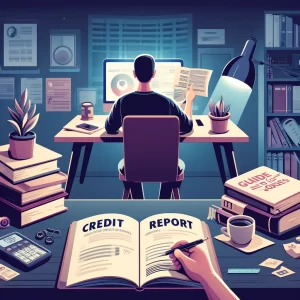
Handling credit matters might initially appear overwhelming, but grasping the core principles can equip you with the ability to cultivate a strong financial standing. This comprehensive guide will walk you through interpreting your credit reports, rectifying any inaccuracies, and strategically boosting your credit score. Let’s commence by revisiting the basics.
Step 1: Obtain Your Credit Reports
Obtain copies of your credit reports from the three primary credit bureaus. This foundational measure is pivotal for gaining insights into your present credit situation and pinpointing any erroneous information that could be adversely influencing your financial well-being.
Step 2: Opt Out of Unsolicited Credit Offers
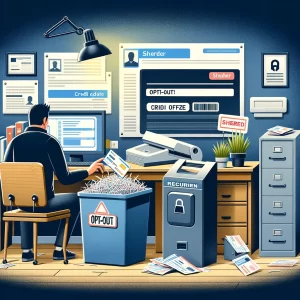
Safeguard your personal information and mitigate the risk of identity theft by choosing to opt out of receiving unsolicited credit card offers and loan solicitations. Furthermore, implement a credit freeze on your reports to prohibit unauthorized parties from accessing and manipulating your financial records. Any inaccuracies or inconsistencies found within these reports can have a detrimental impact on your credit score.
Step 3: Thoroughly Review Your Credit Reports
Carefully review each section of your credit reports for accuracy. Make sure they are 100% accurate and complete. Credit reports can be intimidating at first. Each one will contain the same information that includes:
- Personal Information: Your name, address, Social Security number, date of birth.
- Credit Accounts: Details of your credit accounts including banks, credit card issuers, and other lenders. This includes the type of account (mortgage, auto loan, credit card), the date you opened the account, your credit limit or loan amount, account balance, and your payment history.
- Credit Inquiries: A list of entities that have requested your credit report, such as lenders when you apply for a loan or credit card.
- Public Records: Bankruptcies, foreclosures, lawsuits, wage attachments, liens, and judgments.
- Collections: Past due accounts that have been turned over to a collection agency
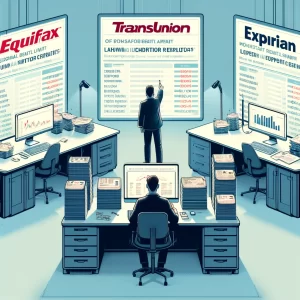
Although the presentation of the information may vary, the core data remains consistent across credit reports. However, it’s important to note that not all creditors report to all three major credit bureaus. You might have a creditor that exclusively reports to Equifax, for instance. In such cases, the other two bureaus, TransUnion and Experian, would be unaware of that particular account since they have not received any information regarding it.
Creditors do not necessarily update information simultaneously. Typically, they report data around the time when your billing cycle is due, which is approximately every 30 days. The credit bureaus, on their end, will incorporate these updates anywhere from the same day to up to a week later. This discrepancy in reporting timelines is the reason why you may find one of your accounts listed on only one of your credit reports, and consequently, your credit scores may vary across the different bureaus.
Do not worry about your credit score. Technically you don’t have a credit score until your file is pulled and then it is calculated. It’s not saved, and you can’t use a previous score. Credit files change frequently. As information comes in from different sources, files are updated. Any information that is added to your file is going to impact your credit score.
There are too many factors that go into the calculation of credit scores. Your credit score is based on the information in your credit file. If your reports look good, your score will be good.
Your initial focus for review and rectification should be your personal details. This step establishes the foundation before initiating any disputes for successful credit repair. The personal identifiers to verify include:
- Your full name
- Residential address
- Date of birth
- Social Security number
- Phone number
Ensuring the accuracy of these core identifiers is crucial before proceeding with further actions.
Consistent Personal Information
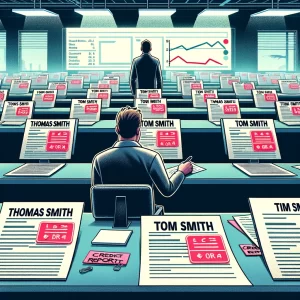
Name: Regarding your name on your credit report, the objective is to have a single, consistent form listed. Or, at the very least, minimize the number of name variations present. If both your maiden name and married name appear, that is understandable, resulting in two forms being listed.
Hyphenated last names can potentially lead to confusion. Data entry errors could occur, causing inaccuracies. For instance, if I applied for a credit card using “Tom” instead of “Thomas,” but the creditor inadvertently entered “Tim” into their system, then “Tim” would be reflected on my credit report. Errors in your name and an excessive number of name variations can create issues. However, no one will proactively notify you about such errors. It is the individual’s responsibility to ensure that their credit report is 100% accurate.
Merged or mixed credit accounts are a prevalent issue, but they pose a significant problem. This error can lead to the denial of credit lines. Additionally, if the mixed account contains derogatory information, it could cost you potential job opportunities. Surnames are particularly susceptible to identity issues, errors, and merged credit files.
One of the primary reasons for minimizing name variations is to demonstrate stability. Stable individuals are less likely to default on their financial obligations.
Removing extra names from your credit reports will not only increase your score but also separate your file from those with similar names.
When eliminating names from your credit report, it’s crucial to retain accounts associated with positive credit history.
Let’s revisit the example where a creditor incorrectly entered my name as “Tim” in their system instead of “Tom.” Since no one was verifying for errors, the name on file became “Tim Smith.” However, the payment history on this account is perfect, making it an account I want to retain.
The problem arises when a lender notices the discrepancy between “Tim Smith” and “Tom Smith,” potentially raising suspicions of impropriety.
Additionally, there’s a risk that my credit file could become merged with an individual named “Tim Smith.” While I don’t want to delete this account due to its positive credit history, sending a letter demanding the removal of incorrect names could create complications.
The correct approach to resolve this issue would be to contact the creditor first and inform them of the name inaccuracy. Once the update is made, and the account is correctly tied to “Tom Smith,” I can then send a letter requesting the removal of the incorrect name variations from my credit file.
Choose one form of your name and go with it. For instance:
Thomas A. Smith Jr. – This is the most common structure for financial dealings.
- Arnold Smith Jr. -This is an alternate structure
Thomas Arnold Smith Jr. – This is another alternate structure.
- Maintain uniformity between your legal name and the one utilized across financial records and identification documents.
- If your legal name includes a suffix, ensure its consistent usage, as this will minimize the likelihood of your credit file becoming mixed with others.
- Prior to submitting applications, meticulously review and verify the accuracy of all details provided.
- Avoid the use of nicknames on legal documents to prevent potential discrepancies.
Address Discrepancies and Errors

Address: It is not uncommon for multiple addresses to be listed in your credit reports. These could include your childhood home, a rental property you resided in, or perhaps a friend’s address that you temporarily used.
However, the addresses you want to maintain on your reports are:
- Your current residential address
- Accounts associated with established positive credit history
- Properties you have owned with a mortgage that was paid on time
These types of addresses hold value for credit reports. While having a few addresses listed is normal, an excessive number, such as 10 different addresses, may raise concerns. If a lender is considering extending you a line of credit and notices several different addresses, they may question the reasoning behind such frequent relocations. The concern arises as to whether you will make the monthly payments on time if offered credit, or if you will simply change addresses, leaving the lender in a difficult situation.
Phone numbers: Verify that the phone number listed on your credit reports is your current and accurate personal phone number. Credit reports have been known to erroneously list an individual’s work phone number as their primary contact number instead of their personal number.
Social Security Number: Carefully review your Social Security number and date of birth to ensure their accuracy. Any inaccuracies or errors related to these personal identifiers can create potential problems and complications for you in the future.
Sample letter to download Sample letter
When submitting supporting documentation for identification purposes along with your dispute letters, providing more forms of identification is better than 2 forms of identification. Sending two types of ID has an acceptance rate of 76%. However, if you include three forms of ID, the acceptance rate increases to 86%. Furthermore, if you provide four forms of identification, the acceptance rate rises to an impressive 92%. This principle applies to all types of disputes you may file with the credit bureaus only.
ID types:
- Driver’s license
- Utility bill
- Bank statement
- State ID
- Voter registration card
- Personal voided check.
- Paycheck stub
- Mortgage statement
- Passport
- Rent agreement.
NOTE:
It is crucial to maintain honesty when communicating with credit bureaus. In your letter, only list the names and addresses you want to be listed on your report. It is unnecessary to give any explanation for addresses you want deleted. They only need to know what your current address is.
After submitting this letter to the major credit bureaus—Experian, Equifax, and TransUnion—it is also essential to send it to other lesser-known credit information sources to ensure comprehensive correction of your records.
LexisNexis Consumer Center
PO Box 105108
Atlanta, GA. 30348-5108
Phone: 1-888-497- 0011
__________________________
SageStream LLC
PO Box 503793
San Diego, Ca.,92150
Phone: 1-888-395-0277
Merged/Mixed Credit Accounts
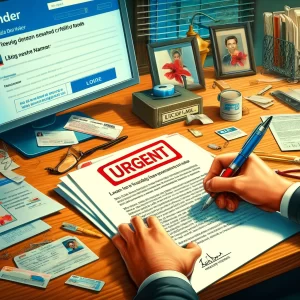
The next step involves resolving merged or mixed credit files. If you do not have a mixed credit file, you can skip this information and proceed to the next step.
However, if you do have a mixed credit file, it is advisable to address this error before disputing more complex issues. At this stage, your personal identifiers should be accurate. Merged accounts are a common problem for names that include suffixes like Jr., II, or III. Those with common names or names that can be spelled differently may also experience merged accounts.
You have already determined the preferred name format you will use moving forward.
If you are certain that another person’s credit file has been improperly merged with your own, it is crucial to send a truthful and sincere letter. Include at least two forms of identification that can validate your name and address. However, remember the acceptance rate statistics mentioned earlier, which suggest providing more forms of identification increases the likelihood of acceptance.
To ensure your letter stands out and does not appear as a generic template found online, you can write “URGENT” in red at the top of the paper. This is also an opportune time to conduct a search of your first and last name. Perform a Google search for your name and observe how many individuals share the same first and last name.
Additionally, visit LinkedIn.com and enter your first and last name in the search bar. Look for the option that states “See all people results.”
If there is a significant number of individuals with the same name as yours, include this information in your letter. Incorporate a statement such as, “On LinkedIn.com alone, there are XX number of people with the same name as mine.”
Sample letter for Merged Credit Files
By now you have checked to make sure that all your personal identifiers are correct across the 3 main credit bureaus and the lesser known data collectors. And you made sure that you do not have any information that belongs to someone else in your file.
If your reports are 100% correct, then all that is left to do is review your reports annually to maintain a clean record and to stay on top of any accounts that may have been opened without your permission.
Although if you have derogatory items on your report that you want removed you can move on to the next step.
Mastering Credit Management: Essential Strategies and Insights
2

Step 1 is universal; you can’t go into the process blind. You need to know what is in your profile that the credit bureaus store about you. Only you are going to know if there are any errors in your credit file by reviewing your credit reports. Since creditors and lenders are not required to report to the credit bureaus.
And the credit bureaus only know what is reported to them, ordering your reports from them is important. You only want to address errors with the credit bureau that shows errors on their report of you. With the assumption that you ordered and now have your credit reports. Here are three things to do before you inform the credit bureau of any errors. Below are three actions you can do before you begin disputes.
Navigate Credit Offers Wisely
By staying informed about common financial practices and understanding marketing motivations, you can shield yourself from deceptive offers and make well-informed financial decisions. I thought receiving offers in the mail for credit cards was because I had good credit. Because credit card offers don’t come in the mail when your credit is bad. Although, these credit card offers do not guarantee that line of credit.
The credit bureaus are a storage house for your file. Containing information reported to them by your creditors. Your creditors own the information they are reporting. Credit bureaus assume the information is accurate. The credit bureaus also sell the information to other creditors, loan providers, insurance providers and mortgage companies.
Loan providers and credit card companies are aiming to offer credit to consumers. But not all consumers are going use credit responsibly. They want to find the consumers who pay their debts. Surprisingly credit scores are a great indicator for that. Creditors and lenders use software that analyze credit reports based on specific criteria.
Such as, targeting consumers with credit scores ranging from 600 to 680. Because they know consumers who fall into that range are more likely to accept higher interest rates compared to consumers with excellent credit scores. Or a creditor might want to target individuals who have high credit scores but are currently underserved by their existing credit cards.
You want the right amount and mix of credit to earn the most points whenever your credit score is calculated. In terms of credit cards, 3 earns the most points. But more importantly, being able to manage them well is what’s going to build a solid credit profile. If you feel ready to take on credit by applying for a loan or a credit card. You can easily search online for options. You don’t need mailing offers.
Shield Your Finances: How Opting Out at OptOutPrescreen.com Protects You From Identity Theft
Opting out helps to prevent credit card offers from falling into the wrong hands, as criminals could exploit them to steal your identity. Fraudsters could apply for credit in your name, accumulate debts without your awareness, leading to collections and ugly credit reports. You can opt-out at www.optoutprescreen.com
If you fall victim to identity theft, immediate action is necessary to minimize damage and safeguard yourself:
- File a Report: Contact your local police department to file an official report of the identity theft.
- Contact Credit Bureaus: Notify major credit bureaus—Experian, Equifax, and TransUnion—about the identity theft. Request a fraud alert on your credit report to prompt creditors to verify your identity before extending credit.
- Maintain Detailed Records: Keep thorough records of all communications, transactions, and documents related to the identity theft, including copies of correspondence and police reports.
- Seek Assistance: If unsure about the necessary steps, consider consulting a certified identity theft specialist or legal professional for guidance.
Take Control: How the Do Not Call Registry Reduces Unwanted Calls and Protects Your Privacy
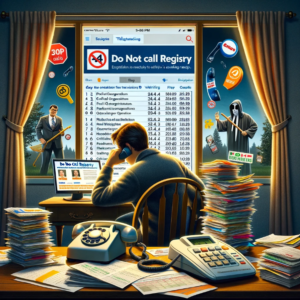
The primary goal of the Do Not Call Registry is to give people a choice about whether they want to receive telemarketing calls at home. It was established to address consumer complaints about unwanted telemarketing calls and to provide a straightforward mechanism for stopping those calls.
This will not stop all solicitation calls altogether. Most telemarketing calls are covered by the registry. However, there are exceptions. Calls from political organizations, charities, telephone surveyors, or companies with whom a consumer has an existing business relationship are allowed. A company may call a consumer for up to 18 months after the consumer’s last purchase, delivery, or payment—even if the consumer’s number is on the registry.
But it will substantially reduce solicitation calls. While some automated systems and international scammers may ignore the registry as well, taking control of your financial matters shouldn’t entail wasting time on fake scare tactics, such as fraudulent calls claiming computer issues from supposed Microsoft representatives.
If you fall victim to a phone scam and provide your banking information to a criminal who proceeds to withdraw funds, your bank will not be liable for reimbursement. Never disclose sensitive information over the phone, especially if you didn’t initiate the call, as the identity of the caller cannot be guaranteed. Registration is quick and easy online, but it takes 31 days to take full effect. Afterward, if a solicitor violates your rights by calling, you have the right to demand compensation or pursue legal action through small claims court. www.DoNotCall.gov.
Lock Down Your Credit: The Essential Guide to Freezing and Unfreezing Your Credit Report

Don’t overlook the importance of freezing your credit reports. Place a freeze on your credit reports now; or if you are in the process of applying for a credit card to build positive credit, do it immediately afterward. Frozen credit reports means no one can open, read, or obtain your credit report. It is “frozen shut.” When applying for credit in the future, instruct the credit bureaus to unfreeze your report for a specific period, such as one week or one month.
If applying for a home loan, your credit reports need to be unfrozen and open to the mortgage lender from the initial application until the loan closes. For other types of credit, inquire about the necessary time period. Allow a couple of days for your unfreeze request to go through.
Experian states that when you execute the request to lift the freeze, it happens in an hour; however, it could take two days to go through. Remember, there’s an additional charge to request it again after lifting the freeze, so don’t overlook this.
Freezing your credit shields you from online identity theft, unauthorized credit usage, and unapproved credit inquiries. However, it doesn’t prevent you from accessing your own credit report, nor does it stop review by current creditors, collection agencies, or landlords.
If you have children, consider freezing their credit to safeguard them from fraud. Freezing their credit is the most effective prevention measure. If a child falls victim to credit fraud, report it to the authorities and provide a copy of the police report to both the creditor and credit bureaus to shut down the account and remove it from the child’s file.
You can easily freeze your credit online, or if preferred, you also have the option to submit a freeze request by mail or telephone. Below are the links for freezing your credit with major credit bureaus:
Experian: Link
Equifax: Link
TransUnion: Link
Innovis: Link
LexisNexis (joint with SageStream): Link
SageStream (joint with LexisNexis): Link
Clarity Services: Link
Once you’ve completed the freezing of your credit, it’s prudent to wait for a two-week period before sending any dispute or challenge letters. Keep in mind, this waiting interval is a critical aspect of the setup process, and exercising patience is paramount.
Beyond the Big Three: Exploring Alternative Credit Sources for a Fuller Financial Picture
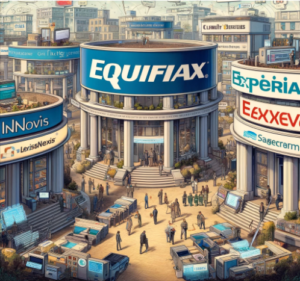
While Equifax, Experian, and TransUnion hold prominence in the credit reporting industry. They are the big three, however, there are other entities that gather and disseminate your private data. Banks, mortgage lenders, and other financial institutions rely on supplementary sources to evaluate your creditworthiness, providing unique perspectives and information not typically found in traditional credit reports.
Comprehending and addressing the insights offered by these alternative credit sources is essential for maintaining an accurate and comprehensive financial profile.
Devoting time to a thorough review and correction of all your personal information is a worthwhile endeavor. Although obtaining additional reports may require some effort, the benefits outweigh the challenges. Credit repair specialists often spend several weeks ensuring their clients’ personal details are accurate across major and minor sources before commencing any dispute procedures. Ultimately this approach saves time, reduces postage expenses, and mitigates frustration.
Overdraft protection plans come with their own set of limits, including how much they cover and how long they last. It’s important to carefully check the specifics of your plan because it might not cover as much as you think.
You can check into alternative option if you are having trouble opening a new account.
- Look for banks or credit unions that don’t rely on ChexSystems or credit reports. GTE Financial’s Go Further Checking, or Varo is an online branch of Bankcorp Bank
- Another approach is to start with a savings account at a small or medium-sized local bank or credit union. Demonstrating responsible savings habits can pave the way for eventually opening a checking account, especially if you consistently increase your savings balance over time.
Fundamental rules:
- Never spend more than you have.
- Avoid dangerously low balances.
- Maintain a cushion of funds in your checking account as a safety net, separate from your regular balance.
This buffer, can be $100 or more, serves as a precaution against overdrafts, fees, and the inconvenience of bounced checks. If tracking your balance is challenging, error on the side of caution and maintain a higher cushion.
The use of personal checks has decreased significantly with the rise of digital payment methods like online banking, and mobile payment apps. Checks remain useful in certain situations where digital payments might not be an option, such as paying rent, settling debts between individuals who prefer not to use cash, or making payments where electronic transfers are not feasible.
They are also used by some who may not have access to banking technology or prefer a more tangible method of payment. Additionally, checks can serve a role in business transactions, particularly among small businesses or in industries that have longer-standing traditions of using checks.
Navigating the Fine Print: Understanding Your Bank’s Checking Account Rules and Overdraft Policies
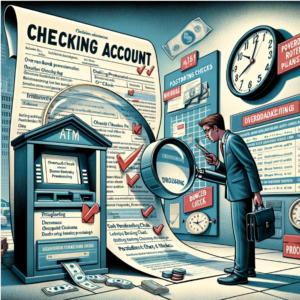
In the checking account agreement for banks are all slightly different from the next. But overall, have similar terms and conditions. They are written with the banks interest in mind. Sometimes overdrafts fees happen and confuse the owner of the account about why the fee was applied. So here are some of the terms that are hard to read in those checking account agreements that have been overlooked.
For instance, if you postdate a check, the bank can choose to process the check before the date specified, and if there aren’t enough funds in the account to cover the check at that time, it could result in the account becoming overdrawn. In such cases, the bank might charge an NSF fee for the returned check, and if they choose to cover the check anyway (resulting in an overdraft), they may also apply an overdraft fee. Similarly, banks could endorse checks on your behalf if you forgot to sign the check.
ATM deposits might not always go through immediately and could cause issues like bounced checks. Cashier’s checks or money transfers need more time to process, so it’s best not to assume you can use that money right away. Also, banks have daily cutoff times for making deposits, if you make a deposit after the bank’s daily cutoff time, your money won’t be available as quickly as you assume. It’s good to know when your bank’s cutoff time is.
Overdraft protection plans come with their own set of limits, including how much they cover and how long they last. It’s important to carefully check the specifics of your plan because it might not cover as much as you think.
SageStream LLC
PO Box 503793
San Diego, CA 92150
Phone: 1-888-395-0277
Clarity Services: Unveiling Creditworthiness Beyond Traditional Scores

- Clarity Services specializes in predictive analytics for individuals with below-prime credit. With the claim of being a “crystal ball” for predicting future payment behavior, Clarity possesses the largest subprime database in the industry, comprising over 62 million consumers. While conventional credit bureaus assess risk based on past payment history, Clarity focuses on financial and personal stability to determine creditworthiness. Factors such as residential stability, employment consistency, and credit application behavior are analyzed to gauge stability. Longer job tenures are generally viewed more favorably.
Employment History: Are you frequently changing jobs, possibly due to being terminated or unreliable work history? On the other hand, do you have a stable and consistent employment record over an extended period, ideally at least one year, but preferably longer without any yearly job changes for the past five consecutive years?
Credit Applications: Have you recently submitted a high volume of credit applications? A large number of inquiries, particularly for multiple credit cards, raises red flags. Similarly, have you applied for multiple mortgage loans, possibly across various online platforms? It’s common to shop around with two or three different mortgage lenders to find the best home loan option. In this scenario, multiple hard inquiries within a certain timeframe are typically combined and treated as a single inquiry by the credit scoring models.
Credit Score Impact: During times when preserving your credit score is crucial, this combined inquiry treatment is beneficial. Three separate hard inquiries can significantly impact your credit score. If your current score is on the cusp of dropping or rising into the next credit scoring tier, you want to avoid a decrease. A lower score can lead to a higher interest rate on loans. Let me illustrate with an example…
The table shows the interest paid on a $20,000 car loan over 5 years across different credit score ranges, we’ll use the average interest rates provided by Experian for each credit score range. Here’s the breakdown of the average interest rates.

Now, let’s calculate the total interest paid for a $20,000 car loan over 5 years (60 months). The formula to calculate the total interest paid on a loan is:
Where:
- ( P ) is the principal amount ($20,000)
- ( r ) is the monthly interest rate (annual rate divided by 12)
- ( n ) is the total number of payments (60 for a 5-year loan)
Using this formula, we can calculate the total interest paid for each credit score range. Here’s the table with the calculated total interest for each credit score range:

Examine the different credit score tiers and the corresponding total interest amounts. If you have an excellent credit score, say 786, you will pay $3,037 in total interest for that auto loan. When shopping for a car loan, your credit happens to be pulled three times by lenders. Each credit inquiry slightly lowers your credit score. If those inquiries cause your score to drop into the next lower tier, it could result in paying $741 more in total interest on the loan. So, a decrease of just 6 credit score points in this example would cost you an additional $741 in interest charges.
According to Clarity, individuals with prolonged job and address stability, who experienced temporary financial setbacks resulting in late payments, are not perceived as high-risk borrowers. They are seen as trustworthy individuals who endured a temporary hardship. Conversely, frequent changes in residence and excessive credit applications may raise doubts about reliability, as individuals might vanish before fulfilling their payment obligations. If your credit profile is less than perfect, consulting your Clarity Report is advisable.
Clarity Services, Inc.
address: PO Box 5717
Clearwater, FL 33758
Phone: 1-866-390-3118
ChexSystems: The Essential Tool for Uncovering Hidden Financial Histories

ChexSystems is a consumer reporting agency that focuses on tracking debit account history rather than credit accounts. During the process of applying for a mortgage or purchasing a home, lenders may obtain a title report that can reveal information not typically found in credit reports.
This information can include:
- Previous foreclosures or short sales
- Bankruptcies
- Tax liens
- Liens from contractors, service providers, or professionals who performed work on your property and were not fully compensated
- Judgments for unpaid bills, including credit card debt
These negative records are linked to your Social Security number and can persist even if they are not listed on your credit report. It is crucial to disclose any adverse financial events from the past decade openly. A knowledgeable loan officer can verify these details with a title company and provide guidance on the appropriate course of action. Falsifying mortgage applications constitutes felony fraud and should be avoided.
If you have been rejected when trying to open a bank account, it might be due to information in your ChexSystems report. You can obtain your ChexSystems Consumer Report annually for free and request your ChexSystems score, which they provide at no cost. However, this score is different from traditional credit scores and follows a unique scoring system ranging from 100 to 899, with higher scores indicating lower risk to lenders.
To order via mail: Chex Systems, Inc. Attn: Consumer Relations
7805 Hudson Road, Suite 100 Woodbury, MN 55125
To order online: www.chexsystems.com
To order by phone or discuss any concerns: (800) 428-9623
Safeguarding Your Financial Identity: Key Steps to Resolve Disputes and Protect Against Fraud

The most common reason for disputes on Consumer Disclosure Reports is identity theft. This can involve unauthorized activities such as check writing, ATM withdrawals, or even opening a joint account through signature forgery. By the time you notice these activities, the damage is often extensive. If you’re a victim of identity theft, your initial step should be filing a police report.
Another significant cause of negative ChexSystems Reports is merged identities, which occurs when another individual’s banking data is erroneously associated with yours due to similar names. It is crucial to review your Consumer Disclosure Report for accuracy in your name, address, date of birth, and social security number. If you find any discrepancies, submit a copy of your ID along with an explanatory letter and request for correction.
It is important to note that any communication with ChexSystems must be truthful and accurate. If you’ve had a check returned due to insufficient funds, contact the bank where the issue occurred and inquire about a “pay for delete” arrangement. Where they may agree to remove the incident from your ChexSystems consumer report upon settlement of the outstanding balance. Do not deny it because banks are not legally obligated to grant this request. But many will agree if approached politely and directed to the right person.
Another significant cause of negative Chex Reports is merged identities, occurring when another individual’s banking data is erroneously associated with yours due to similar names. Review your Consumer Disclosure Report for accuracy in name, address, date of birth, and social security number. If discrepancies exist, submit a copy of your ID along with an explanatory letter and correction request.
Reset Your Financial Future: Overcoming Credit Challenges and Embracing New Banking Opportunities
Negative information on a Consumer Disclosure Report has the life span of five years. Your credit report is seven years for most negative items. You don’t to wait the full duration before opening a new checking account and moving forward financially.
Mistakes are part of life’s lessons; it’s better to learn from them rather than resent them. Some individuals, open accounts without grasping basic financial management principles. The next thing you know issues begin popping up like unchecked spending and account mismanagement. then worry sets in.
Stress levels rise, it’s terrible. You can take the opportunity to acknowledge past errors and commit to making positive changes moving forward. Today is a new day to begin building a better financial track record.
You can check into alternative option if you are having trouble opening a new account.
- Look for banks or credit unions that don’t rely on ChexSystems or credit reports. GTE Financial’s Go Further Checking, or Varo is an online branch of Bankcorp Bank
- Another approach is to start with a savings account at a small or medium-sized local bank or credit union. Demonstrating responsible savings habits can pave the way for eventually opening a checking account, especially if you consistently increase your savings balance over time.
Fundamental rules:
- Never spend more than you have.
- Avoid dangerously low balances.
- Maintain a cushion of funds in your checking account as a safety net, separate from your regular balance.
This buffer, can be $100 or more, serves as a precaution against overdrafts, fees, and the inconvenience of bounced checks. If tracking your balance is challenging, error on the side of caution and maintain a higher cushion.
The use of personal checks has decreased significantly with the rise of digital payment methods like online banking, and mobile payment apps. Checks remain useful in certain situations where digital payments might not be an option, such as paying rent, settling debts between individuals who prefer not to use cash, or making payments where electronic transfers are not feasible.
They are also used by some who may not have access to banking technology or prefer a more tangible method of payment. Additionally, checks can serve a role in business transactions, particularly among small businesses or in industries that have longer-standing traditions of using checks.
Navigating the Fine Print: Understanding Your Bank’s Checking Account Rules and Overdraft Policies

In the checking account agreement for banks are all slightly different from the next. But overall, have similar terms and conditions. They are written with the banks interest in mind. Sometimes overdrafts fees happen and confuse the owner of the account about why the fee was applied. So here are some of the terms that are hard to read in those checking account agreements that have been overlooked.
For instance, if you postdate a check, the bank can choose to process the check before the date specified, and if there aren’t enough funds in the account to cover the check at that time, it could result in the account becoming overdrawn. In such cases, the bank might charge an NSF fee for the returned check, and if they choose to cover the check anyway (resulting in an overdraft), they may also apply an overdraft fee. Similarly, banks could endorse checks on your behalf if you forgot to sign the check.
ATM deposits might not always go through immediately and could cause issues like bounced checks. Cashier’s checks or money transfers need more time to process, so it’s best not to assume you can use that money right away. Also, banks have daily cutoff times for making deposits, if you make a deposit after the bank’s daily cutoff time, your money won’t be available as quickly as you assume. It’s good to know when your bank’s cutoff time is.
Overdraft protection plans come with their own set of limits, including how much they cover and how long they last. It’s important to carefully check the specifics of your plan because it might not cover as much as you think.
Below are four additional credit report sources worth considering:
- Innovis is the fourth-largest credit bureau, closely trailing Equifax, Experian, and TransUnion. It specializes in data collection, particularly in the bankruptcy domain. Notably, major mortgage entities like Fannie Mae and Freddie Mac share home loan data with Innovis.
Innovis
950 Threadneedle Street, Suite 200
Houston, TX 77079-2937
Phone: 1-800-540-2505 and 1-614-223-0690
- LexisNexis is not a credit bureau. They function as a data service provider, gathering comprehensive information on individuals and supplying it to creditors for risk assessment. It’s a significant source for details on unpaid taxes, judgments, liens, and bankruptcies. Mortgage lenders often utilize LexisNexis to cross-check data not included in traditional credit reports.
LexisNexis
Consumer Center PO Box 105108
Atlanta, CA 30348
Phone: 1-888-497-0011
- SageStream is a legitimate credit bureau. It mirrors the data found on LexisNexis, making it crucial to review both reports for consistency and accuracy. SageStream is utilized by various industries, including automobile lenders, utility companies, cell phone services, retail stores, and credit card companies. Therefore, ensuring the accuracy of all reported information about you, including your name spelling, is crucial. Unlike other scoring systems like FICO or Vantage scores, SageStream employs its own credit scoring system, ranging from 001 to 999. This unique scoring system diverges from traditional methods, possibly to differentiate itself and avoid confusion with other credit scores.
SageStream LLC
PO Box 503793
San Diego, CA 92150
Phone: 1-888-395-0277
Clarity Services: Unveiling Creditworthiness Beyond Traditional Scores

- Clarity Services specializes in predictive analytics for individuals with below-prime credit. With the claim of being a “crystal ball” for predicting future payment behavior, Clarity possesses the largest subprime database in the industry, comprising over 62 million consumers. While conventional credit bureaus assess risk based on past payment history, Clarity focuses on financial and personal stability to determine creditworthiness. Factors such as residential stability, employment consistency, and credit application behavior are analyzed to gauge stability. Longer job tenures are generally viewed more favorably.
Employment History: Are you frequently changing jobs, possibly due to being terminated or unreliable work history? On the other hand, do you have a stable and consistent employment record over an extended period, ideally at least one year, but preferably longer without any yearly job changes for the past five consecutive years?
Credit Applications: Have you recently submitted a high volume of credit applications? A large number of inquiries, particularly for multiple credit cards, raises red flags. Similarly, have you applied for multiple mortgage loans, possibly across various online platforms? It’s common to shop around with two or three different mortgage lenders to find the best home loan option. In this scenario, multiple hard inquiries within a certain timeframe are typically combined and treated as a single inquiry by the credit scoring models.
Credit Score Impact: During times when preserving your credit score is crucial, this combined inquiry treatment is beneficial. Three separate hard inquiries can significantly impact your credit score. If your current score is on the cusp of dropping or rising into the next credit scoring tier, you want to avoid a decrease. A lower score can lead to a higher interest rate on loans. Let me illustrate with an example…
The table shows the interest paid on a $20,000 car loan over 5 years across different credit score ranges, we’ll use the average interest rates provided by Experian for each credit score range. Here’s the breakdown of the average interest rates.

Now, let’s calculate the total interest paid for a $20,000 car loan over 5 years (60 months). The formula to calculate the total interest paid on a loan is:
Where:
- ( P ) is the principal amount ($20,000)
- ( r ) is the monthly interest rate (annual rate divided by 12)
- ( n ) is the total number of payments (60 for a 5-year loan)
Using this formula, we can calculate the total interest paid for each credit score range. Here’s the table with the calculated total interest for each credit score range:

Examine the different credit score tiers and the corresponding total interest amounts. If you have an excellent credit score, say 786, you will pay $3,037 in total interest for that auto loan. When shopping for a car loan, your credit happens to be pulled three times by lenders. Each credit inquiry slightly lowers your credit score. If those inquiries cause your score to drop into the next lower tier, it could result in paying $741 more in total interest on the loan. So, a decrease of just 6 credit score points in this example would cost you an additional $741 in interest charges.
According to Clarity, individuals with prolonged job and address stability, who experienced temporary financial setbacks resulting in late payments, are not perceived as high-risk borrowers. They are seen as trustworthy individuals who endured a temporary hardship. Conversely, frequent changes in residence and excessive credit applications may raise doubts about reliability, as individuals might vanish before fulfilling their payment obligations. If your credit profile is less than perfect, consulting your Clarity Report is advisable.
Clarity Services, Inc.
address: PO Box 5717
Clearwater, FL 33758
Phone: 1-866-390-3118
ChexSystems: The Essential Tool for Uncovering Hidden Financial Histories

ChexSystems is a consumer reporting agency that focuses on tracking debit account history rather than credit accounts. During the process of applying for a mortgage or purchasing a home, lenders may obtain a title report that can reveal information not typically found in credit reports.
This information can include:
- Previous foreclosures or short sales
- Bankruptcies
- Tax liens
- Liens from contractors, service providers, or professionals who performed work on your property and were not fully compensated
- Judgments for unpaid bills, including credit card debt
These negative records are linked to your Social Security number and can persist even if they are not listed on your credit report. It is crucial to disclose any adverse financial events from the past decade openly. A knowledgeable loan officer can verify these details with a title company and provide guidance on the appropriate course of action. Falsifying mortgage applications constitutes felony fraud and should be avoided.
If you have been rejected when trying to open a bank account, it might be due to information in your ChexSystems report. You can obtain your ChexSystems Consumer Report annually for free and request your ChexSystems score, which they provide at no cost. However, this score is different from traditional credit scores and follows a unique scoring system ranging from 100 to 899, with higher scores indicating lower risk to lenders.
To order via mail: Chex Systems, Inc. Attn: Consumer Relations
7805 Hudson Road, Suite 100 Woodbury, MN 55125
To order online: www.chexsystems.com
To order by phone or discuss any concerns: (800) 428-9623
Safeguarding Your Financial Identity: Key Steps to Resolve Disputes and Protect Against Fraud

The most common reason for disputes on Consumer Disclosure Reports is identity theft. This can involve unauthorized activities such as check writing, ATM withdrawals, or even opening a joint account through signature forgery. By the time you notice these activities, the damage is often extensive. If you’re a victim of identity theft, your initial step should be filing a police report.
Another significant cause of negative ChexSystems Reports is merged identities, which occurs when another individual’s banking data is erroneously associated with yours due to similar names. It is crucial to review your Consumer Disclosure Report for accuracy in your name, address, date of birth, and social security number. If you find any discrepancies, submit a copy of your ID along with an explanatory letter and request for correction.
It is important to note that any communication with ChexSystems must be truthful and accurate. If you’ve had a check returned due to insufficient funds, contact the bank where the issue occurred and inquire about a “pay for delete” arrangement. Where they may agree to remove the incident from your ChexSystems consumer report upon settlement of the outstanding balance. Do not deny it because banks are not legally obligated to grant this request. But many will agree if approached politely and directed to the right person.
Another significant cause of negative Chex Reports is merged identities, occurring when another individual’s banking data is erroneously associated with yours due to similar names. Review your Consumer Disclosure Report for accuracy in name, address, date of birth, and social security number. If discrepancies exist, submit a copy of your ID along with an explanatory letter and correction request.
Reset Your Financial Future: Overcoming Credit Challenges and Embracing New Banking Opportunities
Negative information on a Consumer Disclosure Report has the life span of five years. Your credit report is seven years for most negative items. You don’t to wait the full duration before opening a new checking account and moving forward financially.
Mistakes are part of life’s lessons; it’s better to learn from them rather than resent them. Some individuals, open accounts without grasping basic financial management principles. The next thing you know issues begin popping up like unchecked spending and account mismanagement. then worry sets in.
Stress levels rise, it’s terrible. You can take the opportunity to acknowledge past errors and commit to making positive changes moving forward. Today is a new day to begin building a better financial track record.
You can check into alternative option if you are having trouble opening a new account.
- Look for banks or credit unions that don’t rely on ChexSystems or credit reports. GTE Financial’s Go Further Checking, or Varo is an online branch of Bankcorp Bank
- Another approach is to start with a savings account at a small or medium-sized local bank or credit union. Demonstrating responsible savings habits can pave the way for eventually opening a checking account, especially if you consistently increase your savings balance over time.
Fundamental rules:
- Never spend more than you have.
- Avoid dangerously low balances.
- Maintain a cushion of funds in your checking account as a safety net, separate from your regular balance.
This buffer, can be $100 or more, serves as a precaution against overdrafts, fees, and the inconvenience of bounced checks. If tracking your balance is challenging, error on the side of caution and maintain a higher cushion.
The use of personal checks has decreased significantly with the rise of digital payment methods like online banking, and mobile payment apps. Checks remain useful in certain situations where digital payments might not be an option, such as paying rent, settling debts between individuals who prefer not to use cash, or making payments where electronic transfers are not feasible.
They are also used by some who may not have access to banking technology or prefer a more tangible method of payment. Additionally, checks can serve a role in business transactions, particularly among small businesses or in industries that have longer-standing traditions of using checks.
Navigating the Fine Print: Understanding Your Bank’s Checking Account Rules and Overdraft Policies

In the checking account agreement for banks are all slightly different from the next. But overall, have similar terms and conditions. They are written with the banks interest in mind. Sometimes overdrafts fees happen and confuse the owner of the account about why the fee was applied. So here are some of the terms that are hard to read in those checking account agreements that have been overlooked.
For instance, if you postdate a check, the bank can choose to process the check before the date specified, and if there aren’t enough funds in the account to cover the check at that time, it could result in the account becoming overdrawn. In such cases, the bank might charge an NSF fee for the returned check, and if they choose to cover the check anyway (resulting in an overdraft), they may also apply an overdraft fee. Similarly, banks could endorse checks on your behalf if you forgot to sign the check.
ATM deposits might not always go through immediately and could cause issues like bounced checks. Cashier’s checks or money transfers need more time to process, so it’s best not to assume you can use that money right away. Also, banks have daily cutoff times for making deposits, if you make a deposit after the bank’s daily cutoff time, your money won’t be available as quickly as you assume. It’s good to know when your bank’s cutoff time is.
Overdraft protection plans come with their own set of limits, including how much they cover and how long they last. It’s important to carefully check the specifics of your plan because it might not cover as much as you think.
Mastering Credit Scores for Empowered Financial Decisions
Ordering Your Credit Report
1
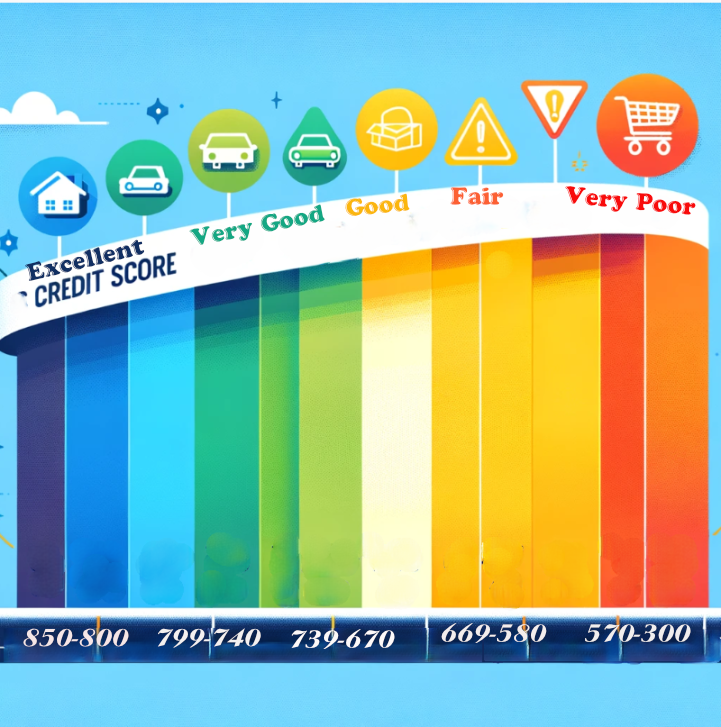
Annual Credit Report Request Service
P.O. Box 105281
Atlanta, GA. 30348- 5281
Click here to Download the sample letter for Ordering your reports
3 digits will indicate whether or not a consumer will be responsible and fulfill financial obligations. Can you handle credit or is it too overwhelming? This number is based on all the information that is found in your credit profile. Your credit profile changes all the time. Data is added and removed from your profile all the time. This results with a different number. The number can be from 300 to 850. The higher the number, the less of a risk you are. Within this range, there are 5 tiers.
- 800-850 Excellent
- 740-799 Very Good
- 670-739 Good
- 580-669 Fair
- 300-579 Very Poor
When Your Credit Score Really Matters
Your credit score is important to know in several key situations where your financial health and capability are assessed by others. Here are some of the main circumstances when knowing your credit score is particularly crucial:
- Applying for a Loan or Mortgage: Lenders will check your credit score to determine your eligibility for a loan and the interest rates you will be offered. A higher score generally means more favorable loan terms.
- Credit Card Applications: When you apply for a new credit card, issuers will look at your credit score to decide whether to approve your application and to set the terms of your credit, such as your limit and interest rate.
- Renting a property: Many landlords use credit scores to assess potential tenants’ reliability. A higher score might improve your chances of securing a rental and could reduce the requirement for a larger security deposit.
- Employment Screening: Some employers check credit scores as part of the background check process, especially for positions that involve financial responsibilities or handling money.
- Insurance Premiums: Insurers may use what’s called a credit-based insurance score to determine your premiums for auto and homeowners’ insurance. A better score can lead to lower premiums.
- Planning Financial Goals: Knowing your credit score can help you understand your financial standing and guide you in improving your financial health, which is beneficial for long-term planning like buying a house or saving for retirement.
- Before a Major Purchase: Checking your score before making large purchases or undergoing significant financial transactions can give you a better sense of what financial products you might qualify for and help you negotiate better terms.
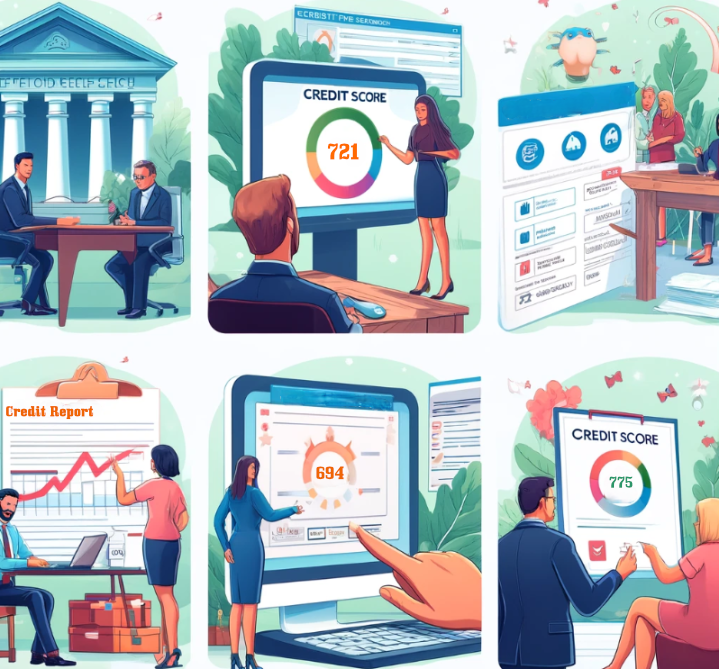
Do not get hung up on your credit score. Your credit score doesn’t exist until your credit is pulled. The FICO’s scoring model will analyze the data in your credit file at that point in time and calculates your credit score. Unless you’re shopping for a home loan or an auto loan, your credit score is similar to a one-time use.
Sometime in the following month your file will be updated. If your credit score is pulled, it will automatically be calculated. It will be a different score.
It’s assumed that credit reports are 100% correct. A lender will not review your credit report with you to make sure everything is correct when you apply for a loan. Your current creditors do not check to make sure there are no overlooked errors in your file when they update it before they report to the credit bureaus.
Evidence shows that the majority of credit reports contain all types of errors. But you’ll never have anyone inform you of errors. Who would even know if your date of birth is wrong on one of your reports? The agency that reviews credit reports and verifies every piece of information on consumer reports is 100% accurate, does not exist. But yet the law states inaccurate information cannot be added to a consumer’s credit file.
The Hidden Errors: Credit Report Inaccuracies
Here are statistics from a study that was conducted by the National Association of State Public Interest Research Groups.
- 79% of credit reports contain errors.
- 54% include personal information that is incorrect.
- 22% of reports have loans that were listed twice.
- 8% of reports were missing positive credit information that boosts credit scores.
- 30% of reports included open accounts that had been closed and paid off. But this can help you if it is a closed account that has been paid-as-agreed. If the closed account has late payments, then it will work against you.
Where is the law at in these situations? Well, the law is waiting for the consumer to request action. Until then, the credit bureaus are not required to do anything. Nothing happens unless a consumer exercises their rights. Unfortunately, consumers are not the credit bureaus customers. We are customers of the furnishers. The furnishers are the credit bureaus customers.
The credit bureaus are just taking the information reported to them and updated the credit files. So, the fault is put on the furnishers. Now the credit bureaus are in the position of taking sides. Do they side with the consumers? Or do they side with their customers?
They are going with whatever their customer says. That is very important,
Practical Tips for Credit Management
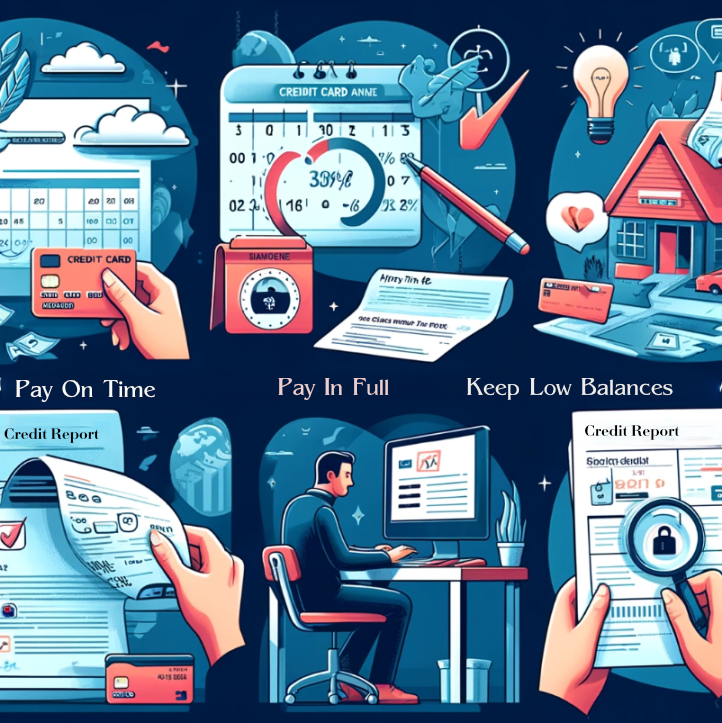
If you do these three things,
- keep your overall balance below 10% when all credit cards combined and individually keep card balances under 10%.
- Pay on time.
- pay off balance when it is due, eliminating the possibility of having a balance roll over to the next month.
You will never have to worry about your credit score. You will know that your score is top notch.
Your job is to review your reports. Every three months request one of the three reports you get for free. Making sure your file has not merged with someone else’s file. You’re also checking for possible identity theft. Making sure all your accounts are accounts that you opened. Keep vigilant about identity theft.
Step 1
The first thing you want to do if you have reports from the credit bureaus that are not more than a year old, review them for any inaccuracies. Otherwise you need to order them. This time you want all three reports. After you clean your report, and you know your credit file is 100% accurate. The following years you can order 1 free report every three months to remain vigilant.
If you didn’t know, reporting information to the credit bureaus is voluntary. So, your three reports may not be the same across the board. Maybe one of your creditors only reports to TransUnion. Your other reports will not have that specific account on them. The credit bureaus are just businesses who collect, store, make available, and sell information about consumer’s creditworthiness. The furnishers who report to the credit bureaus pay them to report. The furnishers are then able to use their databases of consumers and they can then market their financial products to targeted consumers.
Quick overview of the credit bureaus origins

In the retail sector back in the 1800’s small agencies that were local to their area, started collecting information on the creditworthiness of customers and then selling it. That’s when the idea of collecting information about individual’s creditworthiness was formed. In 1899, the Retail Credit Company began collecting and selling customer credit information to businesses.
In 1975, the company became Equifax. TransUnion popped up in 1968, And Experian was a firm that started in 1960 over in the U.K., who expanded their offices to the United States.
Computer technology in the 1960’s and 1970’s allowed credit files to transition into the way credit information is handled today. The FCRA was passed in 1970 because there was an increase of concern with consumer’s about the privacy and accuracy of this data. It is 2024, 55 years later and we still have privacy and accuracy issues.
Back to step 1 in repairing your credit. Request your credit report directly from the credit bureaus through the mail. Before you can dispute any information with a credit bureau, you need to have your official credit report, as it serves as the basis for your challenges. Reports obtained from loan officers or other 3rd party websites won’t cut it; they are the middleman, and you cannot be sure that the information is the same as the credit bureaus.
The free scores these sites provide are not FICO scores. In the credit and mortgage industries, FICO scores are the standard. You can now purchase your consumer FICO score from FICO. Credit scores that are not FICO scores are only good for using as a gauge for your upward progress for credit repair. Such as VantageScore 3.0 and credit monitoring service websites. Do not rely on them because you will set yourself up for a big disappointment.
Use the address below and send a letter to get your credit reports.
Annual Credit Report Request Service
P.O. Box 105281
Atlanta, GA. 30348- 5281
Click here to Download the sample letter for Ordering your reports
This is important, when you send your request for your report, include a large, clear and clean photocopy of your state ID or driver’s license and a document that verifies your name and address such as a utility bill.
ID Types
- Driver’s license
- Utility bill
- Bank statement
- State ID
- Voter registration card
- Personal voided check.
- Paycheck stub
- Mortgage statement
- Passport
- Rent agreement.
You do this for 2 reasons:
- To prevent identity theft and fraud.
- The bureaus have claimed that some consumers do not send proper identification. Or they cannot read the address on ID’s. They are just stalling, making it harder for consumers.
It is also important that you use a standard #10 business envelope with a first-class mail stamp. This letter can be sent without being certified. Future letters will, but not this one The reason being, certified mail provides you with:
- A paper trail of your dispute process if the need for it comes around.
- Someone needs to sign for the letter. The credit bureaus process millions of credit information every month, it would be too easy for them to say they never received it.
- It works as a timestamp starting their 30-day timeframe to open a dispute, investigate, and respond to your request. If they fail to meet the time limit, the error has to be deleted even if they verify the information as accurate.
Do not order your reports by phone because it’s too easy for anyone to call and request your reports. And receive your information by impersonating you.
And never use the online dispute system. Why?
Behind the Scenes: The Credit Dispute Process

Most people generally expect that an “investigation” into a credit card or loan dispute would include activities such as examining documents, investigating facts, talking to witnesses, or comparing handwriting signatures.
Online dispute system was not designed with consumer’s interest in mind. It’s meant to eliminate as many disputes as fast as possible. E-OSCAR (Online Solution for Complete and Accurate Reporting) is a highly automated, computer-based system that essentially bypasses any thorough investigation.
This system simplifies detailed dispute letters to a two- or three-digit codes, occasionally accompanied by a short narrative. The credit reporting industry communicates disputes to data furnishers using a standardized form called Automated Consumer Dispute Verification (ACDV) form. The credit bureaus initiate investigations with furnishers by sending an ACDV.
An ACDV typically includes a few key pieces: the consumer’s identifying information from the credit bureau’s records, the code that summarizes the consumer’s dispute, and occasionally, a brief narrative of one line that adds context to the code. Some of those code options are
- Not his/hers
- Disputes present/previous Account Status/History
- Claims Inaccurate Information. Did not provide specific dispute
- Disputes amounts
Credit bureau employee selects an appropriate dispute code from a list of twenty-six available options from a dropdown menu.
The code is transmitted to the furnisher without any of the supporting documentation that the consumer provided—documents like account applications, billing statements, letters, and payoff statements that could provide substantial, even decisive, evidence. This omission of crucial documents from the investigation process could potentially breach the Fair Credit Reporting Act (FCRA). But, this is the way it is. You need to work with it because it is not going to change.
After allegedly conducting an investigation, the credit bureaus send out generic and vague letters claiming that an investigation has been completed. These letters lack any specifics about whom they contacted or what information was gathered and used to reach a final decision. Once you request that information, the credit bureau is required to provide it for you.
Furnishers just check a box to confirm that the disputed information has been verified. Often, furnishers are just verifying the existence of disputed information, instead of actually investigating the dispute. They will not actually research the underlying dispute, review documents, or speak to consumers about the dispute. Instead, these furnishers simply confirm that the information in the ACDV matches their computer records, and then verify the disputed information to the credit bureaus.
Now you know what goes on behind the curtain. I cannot guarantee success with these steps because even with laws set in place, no one really knows what the credit bureaus will do. But you can follow what successful credit repair experts do to get results.
Credit Repair Company: The Horrible Truth
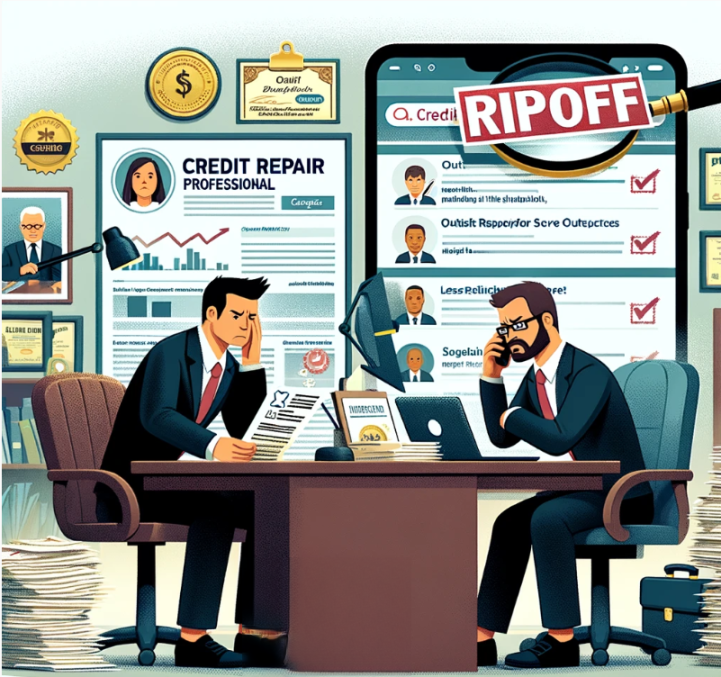
The credit repair business seems to be a perfect avenue for the inexperienced and the scammers who just want your money. Because there is one major aspect that a consumer cannot control. What the credit bureaus will do? Laws are ignored, loopholes are used.
Which is why nobody can guarantee results. They can only guarantee a credit repair business can give is to do their best and will not give up. The perfect excuse for the inexperienced and scammers. They charge you an arm and a leg, and at the end when they don’t come through and then you now have to pay for the expensive service that you feel swindled from. While they claim they did their best and they didn’t give up after sending 3 rounds of letters. Results cannot be guaranteed.
The Credit Repair Organizations Act
The Credit Repair Organizations Act is the law that protects the consumer from the bad guys. Here is an overview:
-
Prohibited Practices: CROA outlines specific practices that credit repair organizations are forbidden from engaging in. For example, these organizations cannot make false or misleading statements about their services, such as guaranteeing to “erase bad credit” or to completely remove accurate negative information from a consumer’s credit report.
-
Disclosure Requirements: Credit repair organizations are required to provide a written contract to consumers that outlines the services to be performed, the payment terms, and a detailed timeline for when the services will be provided. Consumers also have the right to cancel this contract within three days without any penalty or obligation.
-
False Claims: Organizations are barred from making any false claims about their abilities to improve a consumer’s credit score, and they cannot create a “new” identity legally for a consumer by using a different social security number or other federal identification.
-
Litigation: Consumers have the right to sue credit repair organizations for violations of the CROA. If successful, they may be entitled to recover damages, attorney’s fees, and costs.
- Payment Structure: The act prohibits these organizations from charging or receiving any payment until the promised services have been fully performed. This provision is designed to protect consumers from paying for services that do not meet the promised outcomes.
Some individuals may not have the time or patience to work on improving their credit. But might have the financial resources to hire a professional. Thankfully, there are reputable companies available that can effectively handle the job. However, it’s important to be careful and ensure that you don’t end up wasting your money. You should be wary of credit repair companies that outsource their services or yield minimal results even after working on your credit for over a year, leading to prolonged and unproductive efforts.
Number 5, payment structure above regulates credit repair companies from receiving payment until the promised services are complete. Credit Saint has a good track record, but they ignored number 5 because there is an initial working fee. I have noticed quite a few credit repair companies have this junk fee.
Many people from other industries decide to get into credit repair such as Loan officers, former schoolteachers and Entrepeneur’s. You need to be careful if you decide to go down this road. Here is a scenario for you; I call a credit repair company and ask how many years’ experience their credit repair expert has.
They tell me 8 years’ experience. What they don’t tell me is that the credit repair company is a franchise. The franchise has successfully been around, operating for 8 years. And the “expert” really has 7 years’ experience reviewing credit reports as an underwriter. And only 18 months real-world hands-on credit repair experience.
If you are going to hire a credit repair company, make sure they have at least 5 years hand on experience. You’ll need to do some research. Such as checking for any posted complaints for the company over at www.ripoffreport.com.
Search for complaints by doing a Google search on the company, also search for the company on Yelp.com
Checklist For Finding A Reputable Credit Repair Company
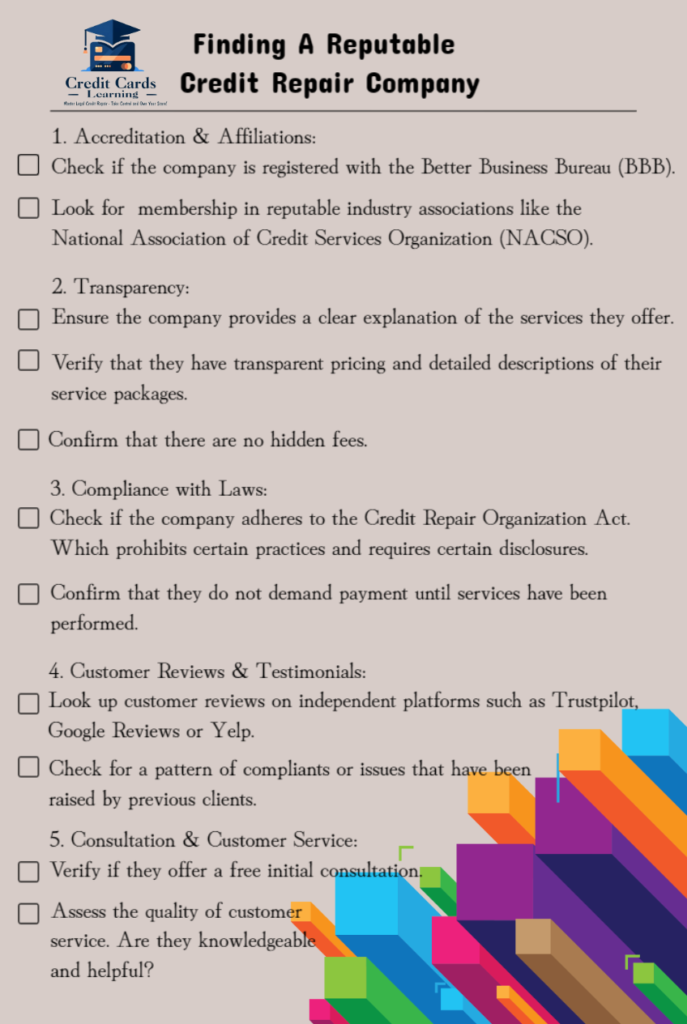
Mastering Your Credit: Unlock the Secrets to a Stellar Credit Score!
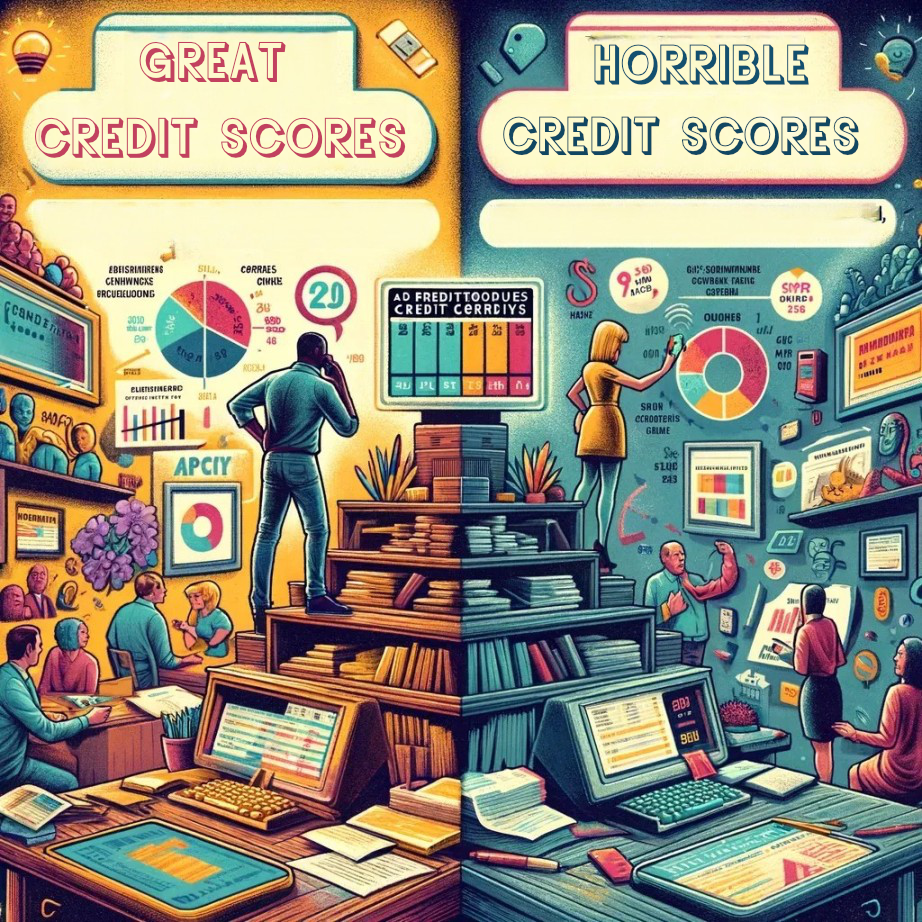
A poor credit file is a file with many late payments, usage on credit cards is close to their limits. Whereas a thin credit file is one with less than 3 tradelines. A credit history consisting of one credit card is notably thin. Lenders want to see that you can manage your money and use credit responsibly. Your credit score tells the lender if you’re a good or bad financial risk. Your credit report is your track record, backing it up.
Debit card usage does not show on credit reports. Money or do they help build credit. Why? Because transactions do not entail borrowing money. Debit card transactions are taken from your banking account, Keep in mind that it typically takes six months for a newly opened revolving account to positively impact your credit score when making timely payments. However, negative activity will show almost immediately.
Does that make sense? Hopefully you’ve begun to establish your credit profile. Let’s explore how the credit scoring system operates. Being well-informed puts you in control of the situation. Here’s the thing, Equifax, Experian, and TransUnion do not maintain ongoing scores. They are not saved. Instead, your credit score is calculated in real-time. Your credit file sits on a server. No one at the credit bureaus review your file. When your credit report is pulled, at that very moment the lender’s calculating software calculates a score based on the information on file at that moment. All the information used to calculate the score, is printed out as your report.
Credit scoring is a complex equation. But this is the question: What is the difference between great credit and horrible credit?
Answer:
- 1.) Pay on time.
- 2.) Keep a low balance-to-limit ratio. (If your balance is over 50% of your credit limit, you will lose points even when making on time payments.
- 3.) Pay the entire balance off when the bill statement arrives.
Let’s continue, the credit bureaus only know what is reported to them. They do not investigate, that’s a key point to know. Their credit investigators are really data entry clerks. If they were allowed to investigate, they wouldn’t know what to do or where to start. They are not qualified to perform investigations. Then again, their definition of a credit investigation is not the same definition the rest of the world knows. The credit bureaus just collect and sell consumer information. I used to think that they were a government agency. Nope, they are just a business, data collectors. There are laws that the credit bureaus have to follow, but there is no law that makes reporting information to them mandatory, it is 100% voluntary. But yet they have more influence over consumers’ lives than any other company. Because the majority of financial dealings depend on the credit scoring system.
The scoring system is software that was introduced in 1956 by Fair, Isaac, and Company. Ever since then they have been the standard. Majority of lenders use FICO’s scoring model. The mortgage industry uses FICO’s scoring model. Furthermore, lenders use a more relaxed scoring model than the mortgage industry. But they are both FICO scoring models. The purpose of Fair, Isaac, and Company software is to give lenders an index of risk.By analyzing all the information in a credit file. It is amazingly accurate most of the time.
If you want your FICO score for free, (myFICO.com/free) this is NOT an affiliate link. Compare FICO score with a free credit score website and find out if they are the same or different.
What Information Is on Your Credit Report
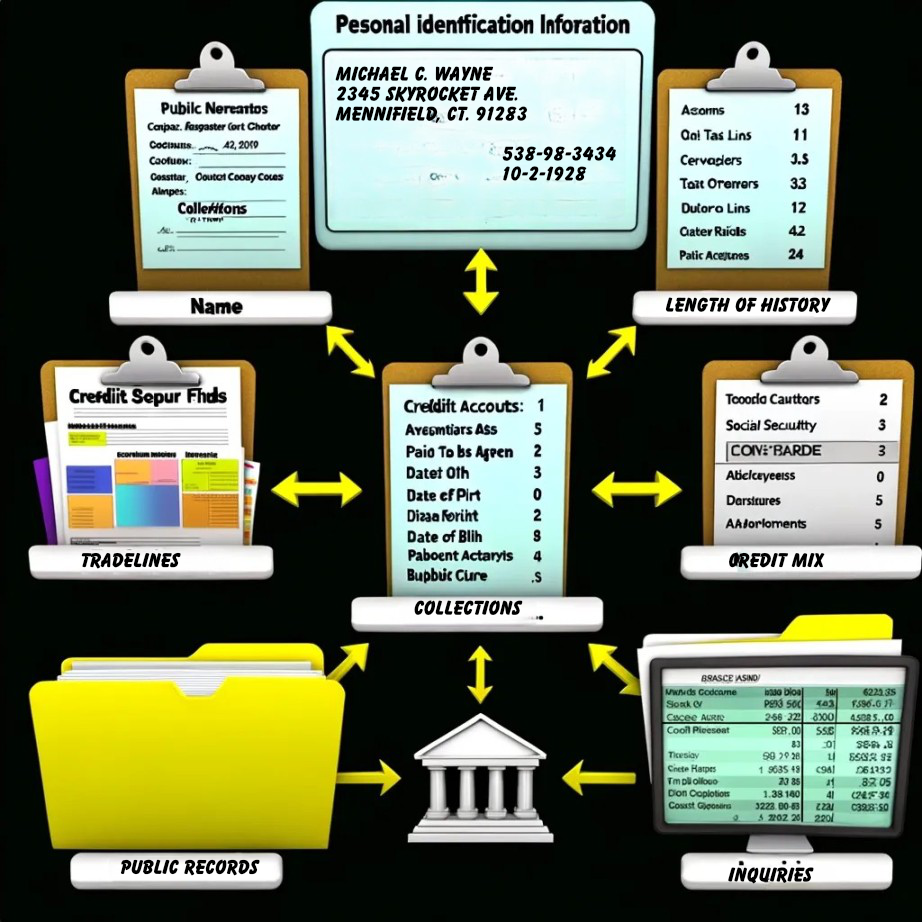
- Personal Identification Information This includes your name, any variations of your name you’ve used, addresses where you’ve lived, date of birth, social security number, and current and past employers.
- Trade Lines These are accounts you currently have or have had in the past seven years. Details provided include the creditor’s name, account number, the highest balance, current balance, and payment history. Payment statuses include “paid as agreed,” 30 days late, 60 days late, and 90-plus days late. Additionally, the report includes the date the account was opened, the closing date if the account is closed, and the Date of Last Activity, which is significant for credit scoring purposes.
- Collections This segment details accounts that are significantly overdue and have been transferred to an external collection agency. If an account is overdue but handled by the collection department of the original creditor, it is still listed under trade lines (this does not improve your score).
- Public Records This section includes information on liens such as tax liens, judgments, and bankruptcies, as well as foreclosures (where a mortgage lender reclaims a home due to non-payment). These are termed public records because they are accessible to anyone who visits a courthouse. Credit bureaus employ a third party to collect this information from public records and report it to them. This is the only type of information for which they pay.
- Inquiries This part lists the creditors who have requested your credit report.
How is Your Score Calculated?
- 35% of your credit score is determined by your payment history. This includes whether you paid your obligations on time as agreed or if there were any delays. Negative credit events like collections, bankruptcy, and foreclosure also fall into this category and can result in the largest point deductions.
- 30% of your credit score is influenced by your debt ratio. Specifically, for credit cards, it examines your balance-to-limit ratio. Utilizing a small portion of your available credit positively affects your score, while being maxed out can negatively impact it. It’s important to note that this only applies to revolving credit, not to installment loans; therefore, having a high balance on your student loan won’t harm your score. Revolving credit refers to accounts that do not have a fixed number of payments, such as those with a Visa card.
- 15% of your credit score depends on the length of your credit history. The age of your accounts matters; a long-standing history of timely payments is beneficial. Achieving a credit score of 800 requires time.
- 10% of your score is determined by the variety of credit types you manage. Holding a mortgage can significantly boost your score. Installment loans, like student loans or auto loans, also positively contribute. Credit cards have a smaller impact. Ideally, having a diverse mix of credit types is beneficial for the consumer. Do not take out loans from payday loans or finance with a finance company because they are hard money lenders. It doesn’t matter if you pay the loan off in time, they will negatively affect your score.
- 10% of your credit score is influenced by inquiries. Why is this significant? If you have multiple inquiries from different credit card companies in a short period, it could suggest that you’re preparing to take on substantial debt. This raises concerns about your capacity to meet existing financial obligations. On the other hand, multiple inquiries from different mortgage lenders or auto finance companies are typically seen as rate shopping for a single house or vehicle, not as intentions to acquire multiple properties or vehicles simultaneously.
There are two types of credit inquiries. One type doesn’t affect your credit score at all, while the other type does impact your score.
Soft Inquiries

A soft inquiry occurs when a credit card company checks your credit report to verify if there have been any recent late payments. This review is performed automatically by computer software that scans millions of credit files. For instance, they might target everyone in certain zip codes who have a credit score above 720 and send them credit card offers. There is just not enough time for them to have an individual do this manually.
Your current credit card and mortgage companies will review your credit report for any late payments to safeguard their interests. If they notice you were late with a payment on your Discover card. Visa might increase your interest rate, even if you’ve always been punctual with them. This is 100% legal as long as they inform you in fine print. They do this under the assumption that you might start falling behind on payments with them as well, viewing you as a high-risk borrower and significantly raise your interest rate to a steep level, such as 32%.
Although, your mortgage company’s loan note prevents them to increase your interest rate based on late credit card payments due to the fixed terms you have agreed upon. But if they do see your falling behind on your financial commitments, they may contact you to offer a refinancing option to consolidate your credit card debt. Often, this isn’t in your best interest, as it involves taking on a larger loan that consumes more of your home equity.
On a Side Note
Consumer Credit Counseling and similar debt management organizations make a situation worse. Creditors often report to credit bureaus that the account is under the management of a debt relief agency. Did you know all lenders look at this as being in a Chapter 13 bankruptcy? Because an account that is in a debt management program shows a lender that the individual is unable to manage their finances on their own. That is the complete opposite of what a lender is looking for.
To top it off, as long as the consumer is in the debt management program making on-time payments, the creditor is reporting the account as being late on payments. Because they have not paid-as-agreed. The agency negotiates a lower payment. This breaks the original agreement with the lender. However, it is possible to secure an FHA loan while enrolled in a Consumer Credit Counseling Service if you meet three specific criteria:
- You have been adhering to the payment plan for a year or more.
- You have made all payments to creditors on time.
- You have received written permission from the CCC Service to apply for a mortgage.
Hard Inquiries

If you’ve ever clicked on an internet advertisement for a mortgage, take note. These ads can be misleading. They might lure you with a simple prompt like, “Find out what rates are in your area,” enticing you to enter your zip code—seemingly harmless at first. However, this leads to more probing questions, and before you know it, you’re providing highly personal details like your social security number, and of course, your email address to receive further information.
Buried within this process is often fine print authorizing them to access your credit report. The need for your social security number is typically for this purpose: to conduct a hard credit inquiry. Unlike a soft inquiry, a hard inquiry occurs when you apply for credit—whether it’s for a credit card, auto loan, mortgage, or personal loan—and the lender checks your credit report with your permission.
Such inquiries will lower your credit score. Statistics indicate that individuals with six or more inquiries in the past year are eight times more likely to file for bankruptcy than those with no inquiries. This underscores why not to let a lot of lenders pull your credit report and why you should not apply for a mortgage quote online from lead generators like Lending Tree who sells your private information to multiple lenders.
Removing Hard Inquiries
If a company pulled your credit without your permission, you have the right to have that inquiry removed from your report. By insisting on verification or validation of the inquiry. Request comprehensive details such as the date consent was given, the method of obtaining consent, the name of the individual who authorized and conducted the credit check and documented proof of consent. If these details can’t be provided, or the provider doesn’t want to provide them, you have the right to have the inquiry removed. Remember, unauthorized credit pulls are illegal.
Sample Letter for Deleting Hard Inquiries
Impact of Inquiries on Your Credit Score
Many individuals are concerned about how inquiries might affect their credit reports and their ability to secure favorable mortgage rates. Inquiries contribute the least to credit scores, making up only about 10%. For the majority, this minimal impact is negligible. However, for those with borderline credit scores—scores that are close to transitioning to a higher or lower category—it’s an important consideration. Here are the FICO credit score ranges, where marginal scores are those on the cusp of entering a new range.
Credit Score Ranges
- 800-850 Excellent
- 740-799 Very Good
- 670-739 Good
- 580-669 Fair
- 300-579 Very Poor
Multiple credit card inquiries can negatively affect your credit score. This is because it’s quite possible to acquire several credit cards simultaneously, significantly increasing your debt and consequently your credit risk.
The impact on your credit score from negative events, like late payments, varies depending on your credit history and there isn’t a fixed number of points that will be deducted. The more time that has elapsed since a negative event, the lesser its impact on your score. For example, a recent 30-day late payment will harm your score more than a bankruptcy that occurred several years ago. This is because, from the credit bureaus’ perspective, an old bankruptcy is considered resolved, while a new late payment might indicate the beginning of financial troubles.
Tips for a Stellar Score
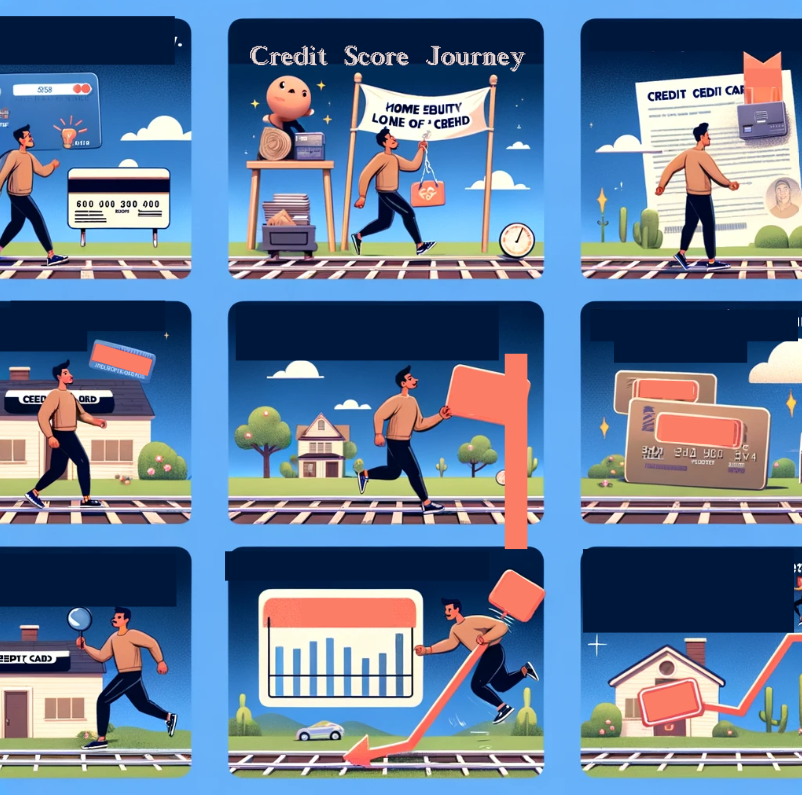
To attain the highest possible score in the shortest duration, here are some of the best practices. Even if they appear challenging, it’s essential to persevere, as you’re cultivating new, beneficial habits that will ultimately help you achieve your financial goals.
Over time, a challenging habit transitions into a routine, then eventually becomes effortless. Like the old saying goes, practice makes perfect. – while initially demanding, with consistency, it becomes more manageable.
- Ensure your balance remains extremely low by refraining from charging more than 29% of the permitted limit. For instance, if your limit is $300, aim to keep the balance below $87, or even lower if possible. Make small purchases, like five dollars, and promptly pay them off upon receiving the bill. Borrowing less associates with better scores. However, it’s essential to use your credit card occasionally to demonstrate responsible credit usage; thus, strive for an “ultra-low” balance rather than completely abstaining from usage.
- Ensure to settle the entire balance in full upon the bill’s arrival. Points will be deducted if you opt for paying the minimum or any amount that carries over part of the balance to the following month. Maintaining a balance does not showcase responsible credit usage. Carrying a balance indicates exceeding your budget and exhibiting poor credit management.
- Utilize more than just one credit card. Solely relying on your preferred rewards card while neglecting others could hinder your efforts to build a strong credit score. Demonstrating responsible management of multiple accounts is key, while ensuring you keep a low balance.
- Here’s a useful tip for homeowners: it’s advisable to refrain from obtaining a Home Equity Line of Credit (HELOC) shortly before seeking additional financing. This is because a new HELOC can temporarily decrease your credit score.
- Regularly utilize each of your credit cards to prevent their closure by the issuer. If a line of credit remains inactive for an extended period, the lender may terminate the account without prior notification. Because if they do not generate revenue from merchant fees or an annual fee, maintaining the open account has no benefit for them. As a result, if your account is terminated, your credit score could decline for two primary reasons. Firstly, the overall available credit limit is diminished, and secondly, the duration of your credit history may be shortened. The duration considered as “a long time” varies depending on the institution. Typically, major credit cards may cancel accounts after 12 to 24 months of inactivity, while store cards often have longer grace periods. It’s easy to overlook a card that isn’t frequently used, and by the time you receive a notification letter regarding its cancellation, it may already be too late to take any corrective action.
Let me give you an example, I have visa, discover, and a Citi cards. The limit on my visa is $1,000. My discover has a limit of $1000. And Citi has a limit of $1000. My overall available credit is $3,000. I just added the limits for each card together for my overall available credit. The three credit cards also get scored individually. This is why credit utilization is important.
Now, I have used $500 on visa and Discover. My Citi card has a $0 balance. I’m utilizing $1000 of the $3000 available. My credit utilization is 33%. I just divided 1 by 3. I will lose points because I am over 30%. Individually, Discover and Visa are both 50% utilized. I will lose points for both cards. I will earn points for my Citi card because there is no balance on it.
Now let’s say Citi card was closed due to inactivity. I will lose the individual points on the card. And I lost $1000 available credit. Now my overall available credit is $2000 and I’m still utilizing $1000 but now my credit utilization is at 50%. When it was at 33%, I lost points, but now that it’s at 50%, my score is going drop a significant amount.
That is the one way a closed account is going to hurt my rating. The second is length of history. Let’s say I had Citi for 3 years. Let’s also say that I was earning 60 points everytime my score is calculated for that one account. If it remains open the account is going to get older and giving more points. But it closed so I still get 60 points for it, but eventually the account will be gone from my reports and if it is a good standing account it’s going to hurt when it is gone.
Strategic Credit Score Boosts

If you were going to apply for a car loan. And you wanted to raise your score, you can ask your creditor to increase the limit. This will raise your overall available credit, at the same time lower the credit utilization. Remember borrowing less associates with better scores.
Now that you know what information is on your credit reports, when your score is calculated and how your score is calculated. You can take all that information and use it to your advantage. For instance, if you significantly reduce your credit card balance, you’re going to earn a lot of points.
However, creditors typically update your payment history monthly. If you make a payment on May 18 and the creditor reports on May 20, but your credit report is pulled on May 19, it won’t reflect this most recent payment and lower balance, so you won’t see the score improvement you earned. Knowing this allows you to strategically time when to authorize a credit check.
Ideally, you’ll maintain a low balance and these strategic boosts won’t even matter. Since reporting dates vary by creditor, you can contact your creditor to find out their specific reporting date, especially if it’s crucial for your plans.
Unlock Financial Success: Why Getting a Credit Card is Your First Step to Achieving Your Goals

Using your credit card responsibly helps you build a strong credit history and achieve a high credit score. This, in turn, qualifies you for lower insurance premiums, favorable auto financing terms, and the best mortgage rates for buying a home. With good credit, you can leverage real estate ownership to build wealth and secure your financial future.
You have the potential to reach your financial goals successfully. It all starts with establishing credit, and the simplest way to begin is by obtaining a credit card. There are various situations where having a credit card is essential. Consider the following scenarios and how they might apply to you now or in the future:
- Immediate access to emergency funds
- Assured optimal exchange rates while traveling overseas
- Extra insurance coverage during international travel
- Safe online shopping
- Easy access to funds without the need for cash
- Financial loss protection in case of card loss or theft
- Complimentary protection for lost or stolen items within a 90-day period
- Benefiting from rewards provided by the card.
A major credit card is especially advantageous in situations such as:
- Renting a car, truck, or moving van
- Handling unforeseen emergencies like a dead car battery
- Applying for a mortgage loan to acquire a home.
- Booking accommodations such as hotels or Airbnb rentals
- Purchasing airline tickets
Major credit cards encompass those accepted at various establishments, such as Visa, MasterCard, Discover, and American Express, while store-specific or gas cards like Target or Costco cards are not considered major credit cards.
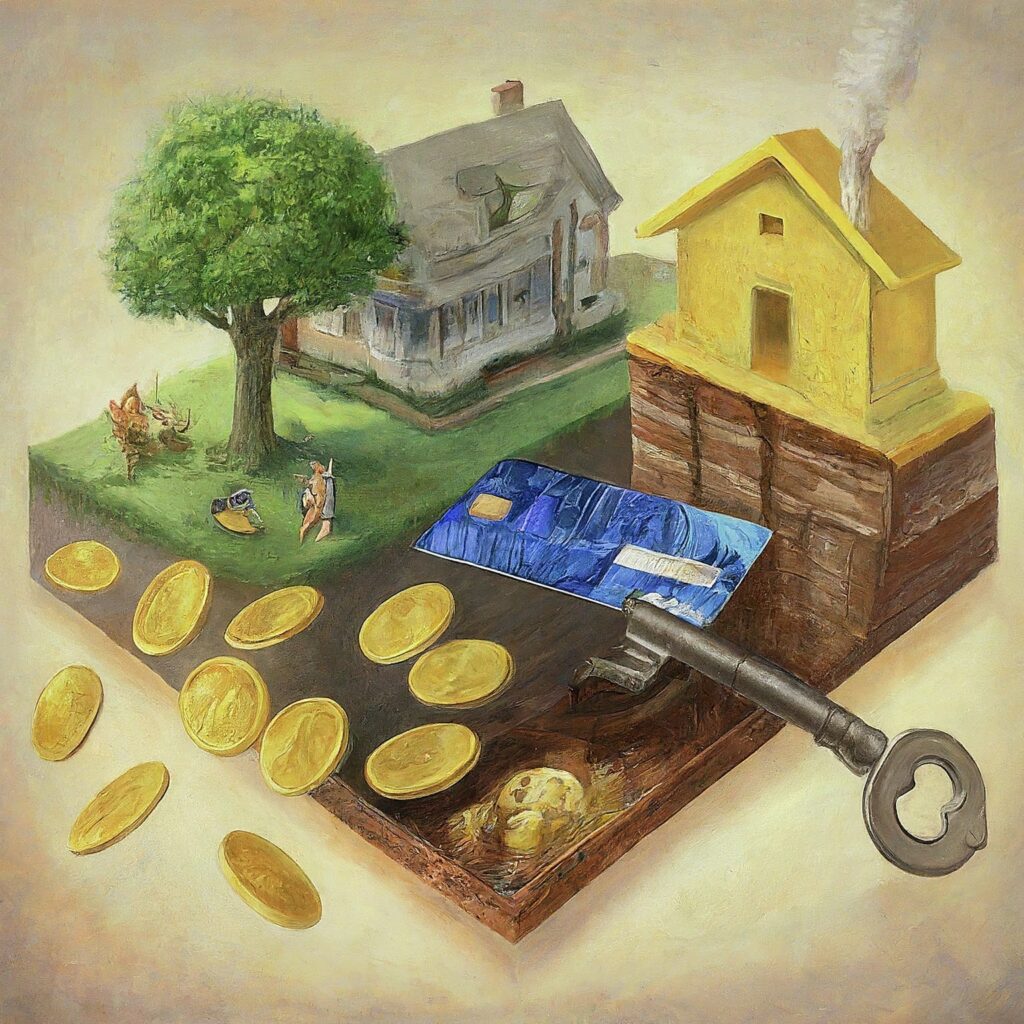
When you own a home, you no longer pay someone else’s mortgage and gain stability against rent increases or eviction. Ultimately, you can own your home outright, generating additional income through renting or selling it. Homeownership also offers tax deductions and potential financial flexibility in your senior years.
It’s essential to recognize the significance of credit and take control of managing it effectively. Understanding the basics of credit is vital for financial well-being and future opportunities. Despite some voices discouraging credit usage entirely, using credit wisely can actually propel you forward financially. Protecting your credit from various threats, such as fraud and theft, is crucial for maintaining financial security.
Your primary goal should be achieving a credit score of at least 740 to avoid unnecessary fees and charges. By aiming for a top-tier credit score, you ensure financial stability. With the right knowledge and strategy, you can build a strong credit profile, avoiding common pitfalls that lead to financial struggles and low credit scores. Within a year, you can build a credit profile so that you have a top-tier credit score that brings you respect. Let’s explore a solid plan to set you on the path to financial success from the outset.
Begin with Your Personal Identification Information

Firstly, determine your preferred name. What does this entail? Select a consistent format for your name and utilize it across all financial and legal transactions. Typically, on mortgage applications, this involves using your first name, middle initial, last name, and any applicable suffixes such as Jr., II, or III. Alternatively, you may choose to include your full middle name.
You want to avoid using only your first and last names, as this may lead to confusion due to similarly named individuals nationwide. Conduct a quick search using search engines like Google or Bing with your first and last name to see how common your name might be. If your name is distinctive or spelled unusually, you may encounter fewer individuals with the same name, but there could be various spellings, including misspellings, on your credit report.
No Nicknames. It’s essential to avoid using your nickname for credit purposes, even if it’s the name you’ve gone by since your first day of Kindergarten. Instead, ensure consistency by using your legal name, aligning it with the information on your social security card and driver’s license, for all credit cards and other accounts. If your name includes a suffix such as Jr., Sr., or III, it’s advisable to include this suffix on all credit and legal documents to minimize the risk of confusion with other family members’ credit profiles.
If you currently have credit accounts open under different variations of your name, there’s no cause for alarm. However, have them removed it’s advisable to standardize your name moving forward. If your credit report lists several variations of your name, consider removing any nicknames or incorrect variations, as doing so could potentially boost your credit score by several points. Additionally, ensure accuracy in providing your date of birth and social security number on credit applications, rental agreements, and cell phone applications.
Pay attention to potential discrepancies, especially when transitioning from a country with a different date format to the United States. For example, individuals moving from countries where dates are expressed as day/month/year may encounter challenges if their date of birth is mistakenly interpreted as month/day/year in the U.S. This discrepancy could lead to delays or complications.
Now that you have a clear plan for establishing credit, you will want to open three accounts, also known as trade lines within the mortgage industry. Mortgage lenders typically prefer a minimum of three accounts to secure the best home loan rates, and having three positive accounts contributes to achieving a top-tier credit score. Having more than 3 credit cards hurts your score. The more you have, the more damage your score takes.
Of the three accounts, at least two should be Visa cards or MasterCards, major credit cards accepted worldwide. These cards carry more weight and flexibility compared to store-specific credit cards. As for the third account, options include an individual store card, a gas card, a student loan, or an automobile loan if needed. It’s worth noting that even a paid-off student loan or auto loan still counts as a trade line on your credit report. Ideally, aim for a combination of two major credit cards and an installment loan, such as a student or auto loan, as this diversification strengthens your credit profile.
Now here’s the thing, if you do not have a credit profile, it may be difficult to be approved for a line of credit. Many creditors will not take the risk when they have nothing to base a decision on. With a poor credit history, the creditor can compensate the risk with higher interest rates.
Is It Wise to Become an Authorized User on a Credit Card?
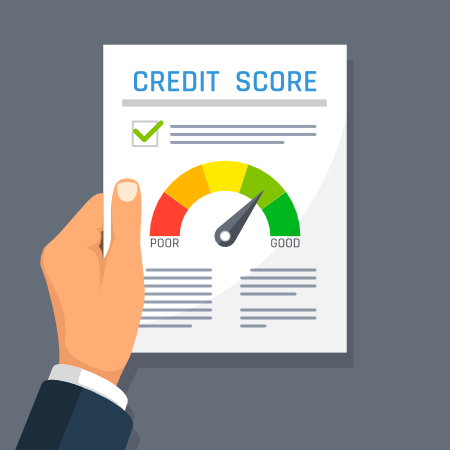
Some young adults contemplate becoming authorized users on their parent’s credit card as a means to build credit. (In this arrangement, the parent owns the card, and it’s in their name, but the authorized user has permission to utilize the card.) This strategy can work only if the parent has A+ Credit rating and maintains low balances on their accounts. And you only use this strategy temporarily. The moment you establish enough credit, that is the moment you say, “thank you”, get off the ride and go your separate ways.
How long does it take to establish credit? Well, if you have:
- One credit card open for more than six months.
- One credit card used at least once in the past six months.
- The credit account is not under dispute for accuracy.
- No notice on the report of you passing away.
You will meet the conditions to receive a credit score. That’s a start, but it’s not enough. Three good accounts result in a top tier credit score. A top tier credit score typically requires two major accounts alongside one store or gas card. The ideal credit mix, assuming the consumer pays the balance in full and on time, every time is a mortgage, installment loan, and a few major credit cards, will earn the most points. After that, the more credit you have the riskier you are to lenders.
However, if the parent consistently maintains high balances but remains punctual with payments, you might reconsider the authorized user approach. Credit scores are influenced by various factors. For instance, a parent with an impeccable payment record—never missing a credit card due date—would naturally anticipate a favorable score. However, if the parent tends to carry significant balances, approaching the credit limit, it could result in the credit account being deemed maxed out. Maxed out credit cards can lead to a sharp decline in credit scores. The extent of this decline depends on the entirety of your credit history. Individuals who frequently miss payments and maintain high balance-to-limit ratios will experience a more substantial loss in points compared to those who consistently make timely payments and keep their balances low.
Alternative Credit Options for Those with Credit Challenges
A secured credit card operates independently of your credit history, instead relying on a deposit you provide to secure your credit usage. For instance, if your bank offers a secured credit card with a $500 limit, you’ll need to deposit $500 into the bank. Upon consistently making timely payments over the agreed-upon period, the card may transition to a standard card with an increased limit. This serves as a viable option if you’re unable to qualify for a traditional credit card. It’s essential to maintain a low balance and pay the bill in full each month to build credit responsibly. Secured cards are available at your local bank, or you can explore options. This is a smalT list to kickstart your journey if you’re looking to add a positive tradeline to your credit profile.
- The Capital One Quicksilver Secured Cash Rewards Card and the Discover It Secured Credit Card.
- The Chime Credit Builder Visa Card doesn’t come with an annual fee but does require you to open a Chime checking account.
- The Capital One Platinum Secured Credit Card entails a deposit of just $49, offering a $200 limit and no annual fee. It proves advantageous if you maintain a balance below $50 consistently and evade the exorbitant interest rates by settling the entire balance each month, thus avoiding any interest charges entirely. Starter cards, on the other hand, don’t necessitate a deposit, though some may impose steep annual fees, warranting caution. While they might carry high interest rates, adhering to responsible card usage and clearing the full balance monthly ensures no interest payments whatsoever.
- The Self credit card be careful of this because it could lead to paying interest on both a credit card and a self-builder loan concurrently.
To attain the highest possible score in the shortest duration, here are some of the best practices. Even if they appear challenging, it’s essential to persevere, as you’re cultivating new, beneficial habits that will ultimately help you achieve your financial goals.
How to Open a Bank Account

If you lack a credit history, begin by initiating a checking account at your nearby bank. Make an in-person visit to ensure satisfactory customer service, should you require face-to-face assistance. Familiarize yourself with the checking account options. The objective is to deposit adequate funds and sustain that balance to avoid monthly fees. If financially viable, consider opening both a checking and savings account to potentially earn higher interest on your savings. Otherwise, focus on a checking account and maintain a sufficient balance to evade unnecessary fees. Subsequently, venture into acquiring a credit card.
For your inaugural credit card, approach the bank where you’ve established your checking account and request one. Typically, this will be a widely accepted Visa or MasterCard. If your bank mandates a secured credit card due to your lack of credit history, it’s a reasonable step. With a secured card, you provide a cash deposit, such as $500, which then determines your credit limit. Even with no credit history, the bank is assured that your deposit can cover any unpaid bills. Keep your balance comfortably below 50 percent of the limit, utilizing the card for routine purchases like groceries, and promptly pay off the bill each billing cycle. Within approximately six months, upon demonstrating responsible usage, your deposit may be refunded, possibly with interest. If there’s a nominal fee associated with the secured card, it’s a worthwhile investment for building credit.
As you progress, consider obtaining a second credit card. Ideally, secure two cards simultaneously to establish two active accounts within six months. Don’t fret if both are secured cards initially; it’s a temporary phase. Aim to achieve a credit score of 740 expeditiously to qualify for a cashback or reward card. Prioritize credit cards without monthly or annual fees, and if you travel internationally, ensure they waive foreign transaction fees. Regarding interest rates, focus on paying off the entire balance monthly and you won’t need to worry about interest rates.
When contemplating additional cards, prioritize store or gas cards for their relative ease of approval. Select merchants you frequent regularly to maximize utility, avoiding excessive gasoline cards due to their limited impact on your credit profile.
Discover it is for People with No Credit History. It is a very good, secured card with no annual fee. You choose your deposit and credit limit with a minimum of $200. If you choose the minimum, then don’t charge more than $60 per month so that you keep your balance-to-limit low. The card reports to all three major credit bureaus. No annual fee.
Credit Card for Students
Capital One has a card for students called Journey. You earn 1% cash back on all your purchases, but don’t let that entice you to over-spending. Listen to logic: you do not come out ahead by spending more to get cash back. They also reward you for paying on time by boosting the cash back to 1.25%. After five months of perfect pay history, they’ll raise your limit, which will improve your balance-to-limit ratio as long as you’re smart and don’t increase your spending. (Your balance to limit ratio holds weight when your scores are calculated, and your file is updated.) There is no annual fee, which is important. You have to make a habit of paying the entire balance every time the bill comes. Because, the Annual Percentage Rate (APR) is grand larceny, 24.99%.
The Self Score MasterCard is good if you’re new to the United States and don’t have a social security card. There is no annual fee, no foreign transaction fee, and no balance transfer fee. To apply, you need a U.S. Passport, a Certificate of Eligibility for Nonimmigrant (Form I-20), a Visa, and a bank account.
Avoid a Credit Card That Doesn’t Report the Limit
A shadow limit occurs when a credit card company neglects to disclose the credit limit to the credit bureaus. Essentially, it’s invisible to you, though it exists. This omission can detrimentally affect your credit score, even if you consistently make timely payments. The issue arises because the credit bureaus lack information about whether your card is fully utilized or if only a fraction of the available credit is being used. In the absence of such data, they assume the worst-case scenario—that you’ve reached your credit limit—and consequently penalize your score. This phenomenon is often associated with the American Express Green card, where the account is assessed as perpetually maxed out.
Earn Rewards by Using Credit
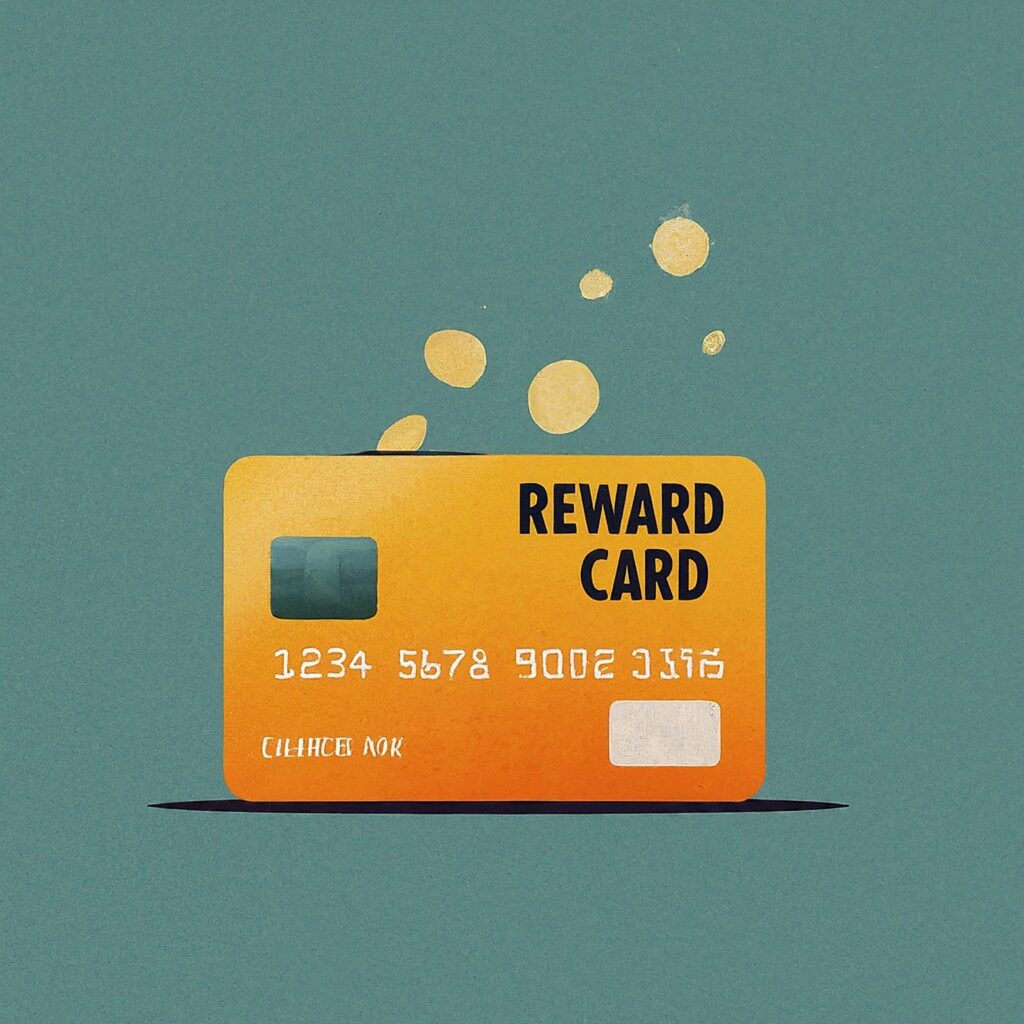
Some credit cards provide rewards for usage, while others don’t. Naturally, most of us prefer to earn rewards, so let’s explore the available options.
Select Your Reward
Credit card issuers offer various rewards to entice individuals with good credit to choose their card over competitors. If everyone paid their balance in full each month, these rewards wouldn’t be feasible. However, since there are enough individuals who may overspend or encounter financial difficulties, banks generate sufficient revenue to offer rewards.
As a wise consumer, you’ll opt for the reward while avoiding interest or penalties.
Here are the three primary types of rewards:
- Cash Back Rewards
- Discover it also provides an outstanding cash back reward card for individuals with good credit. This card offers 5% cash back on rotating categories each quarter, 1% on other purchases, and doubles your cash back after the first year. Remember to manually activate the 5% reward each quarter. You can redeem your cash in various ways, including as a credit on your billing statement or for purchases on Amazon.
- The Chase Freedom Visa card offers similar benefits.
- Citi also provides a Double Cash Credit Card, giving 1% on purchases and an additional 1% as you pay your bill. There are no complex categories or earning caps, and no annual fee. While the interest rate varies based on your credit score, responsible spending and full payment each month make this card appealing.
- Points for Purchase Rewards
This type of credit card rewards points for dollars spent, which can be used for purchasing merchandise. The Amazon Visa card, backed by Chase Bank, offers 3% back on Amazon purchases (5% for Prime members), 2% back at restaurants, gas stations, and drugstores, and 1% on other purchases. It has no annual fee but varying interest rates based on creditworthiness.
- Airline and Travel Rewards
Frequent travelers might benefit from airline credit cards offering discounted or free trips based on accumulated points. However, consider the associated annual fees and whether the benefits outweigh the costs.
For those preferring not to fly, the Discover it Miles card earns 1.5 miles for every dollar spent and matches all miles earned at the end of the first year. These miles can be used for hotel stays, car rentals, or commuter transportation. Always compare the perks and fees before choosing an airline credit card.
Traveling While Rebuilding Credit
If you need to rebuild credit and desire a travel credit card, consider the Aeromexico Visa card offered by U.S. Bank. With a $300 security deposit, this card provides one mile per $1 spent, double on gas and groceries, a 10,000-mile sign-up bonus, and a free companion certificate. However, maintain timely payments to avoid forfeiting rewards.

